Hakone Garden, located in Saratoga, California, is the oldest surviving Japanese-style residential gardens in the Western Hemisphere. It features various elements of Japan's ancient civilization, including hillside gardens, historic buildings, waterfalls, and koi ponds, blending art and nature for a serene experience. The concept of cultivating nature in miniature dates back to 538 AD with the introduction of Buddhism to Japan.
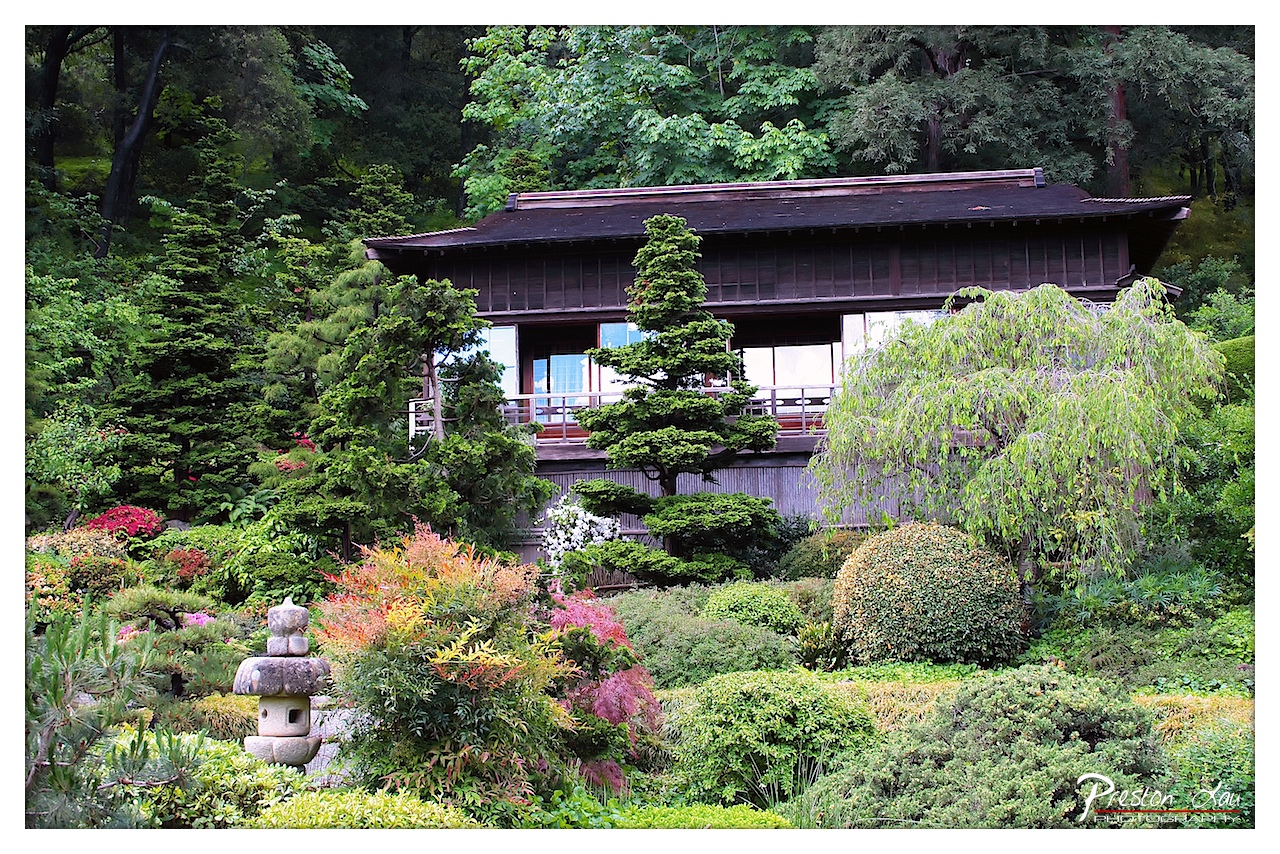

1. Overall Rating (0–10) — 8.0
This photograph captures the serene harmony of a traditional Japanese garden, where architecture and nature coexist in quiet balance. The rich tapestry of textures and colors—ranging from deep greens to soft pinks and golds—evokes a sense of tranquility and timelessness. While the scene is visually compelling, the abundance of detail risks overwhelming the viewer, slightly diminishing the image’s meditative calm.
2. Composition (0–10) — 7.5
The traditional Japanese house is centered and framed by lush foliage, creating a layered depth that draws the eye inward. The stone lantern in the foreground provides a strong anchor and sense of scale, while the weeping tree on the right adds gentle movement. The composition is balanced, though the density of plants in the lower half slightly obscures the garden’s intended flow.
3. Lighting (0–10) — 7.0
Soft, diffused daylight enhances the natural textures and colors without harsh shadows, giving the scene a dreamy, almost painterly quality. The light filters through the trees, creating subtle variations in tone that highlight the garden’s complexity. A slightly cooler tone lends a calm, contemplative mood.
4. Color & Tone (0–10) — 8.0
The palette is rich and varied, with deep greens punctuated by vibrant bursts of red, pink, and yellow foliage. The contrast between the dark wooden structure and the bright flora creates visual interest, while the overall tonal balance feels harmonious and natural. The color temperature supports the garden’s peaceful atmosphere.
5. Creativity (0–10) — 7.5
The image successfully captures the essence of a Japanese garden—intentional design, balance, and quiet beauty. The photographer’s choice to include the stone lantern and the house in a single frame suggests a narrative of human presence within nature, a theme central to Japanese aesthetics. While the concept is familiar, the execution feels authentic and thoughtfully composed.
6. Technical Quality (0–10) — 8.5
The image is sharp and detailed, with excellent clarity in both the foreground and background. Focus is well-managed, allowing the textures of the stone lantern, tree bark, and leaves to stand out. The exposure is balanced, with no blown-out highlights or crushed shadows, and the colors appear true to life.
7. Emotional Impact (0–10) — 8.5
The photograph evokes a deep sense of peace and introspection, inviting the viewer to pause and reflect. The harmonious blend of natural and man-made elements, along with the quiet stillness of the scene, creates a powerful emotional resonance. It feels like a moment suspended in time—calm, meditative, and deeply beautiful.
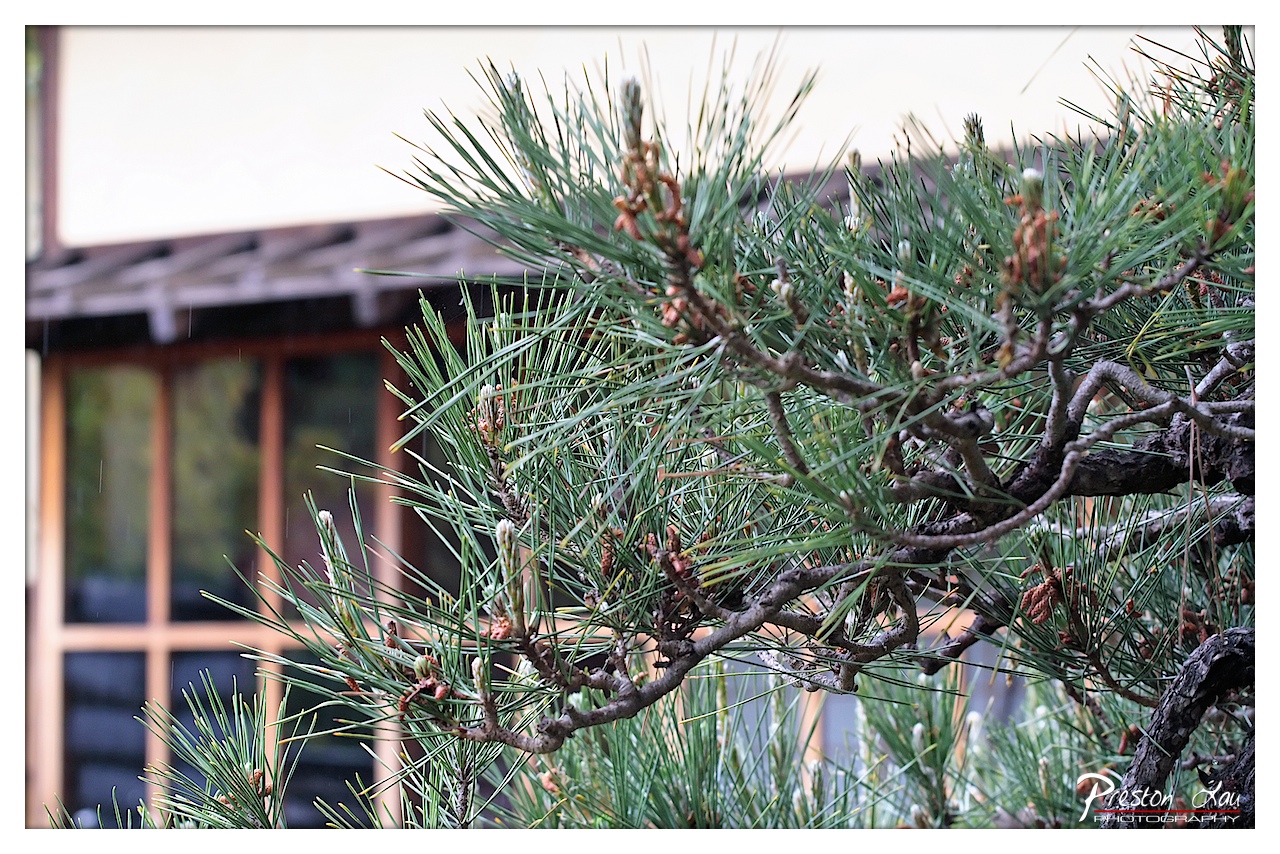

1. Overall Rating (0–10) — 7.5
This photograph captures the quiet elegance of a bonsai pine, its intricate branches and needle clusters rendered with delicate clarity against a softly blurred Japanese-style structure. The shallow depth of field emphasizes the tree’s organic texture and age, evoking a sense of stillness and contemplation. While the composition is strong and the mood serene, the slightly muted color palette and subtle noise prevent it from achieving full visual richness.
2. Composition (0–10) — 8.0
The framing centers the bonsai branch with a balanced diagonal flow, drawing the eye through the natural lines of the needles and twigs. The out-of-focus background provides context without distraction, enhancing the subject’s prominence.
3. Lighting (0–10) — 7.0
Soft, diffused daylight illuminates the scene evenly, highlighting the fine details of the pine needles without harsh shadows. The overcast quality lends a calm, meditative atmosphere, though the lack of directional light slightly flattens the sense of depth.
4. Color & Tone (0–10) — 6.5
The palette is restrained, dominated by earthy greens and browns with a pale background. While harmonious, the colors lack vibrancy, giving the image a muted, almost somber tone that could benefit from slight contrast enhancement.
5. Creativity (0–10) — 7.5
The photographer captures a moment of quiet beauty with intentional focus on natural form and texture. The fusion of traditional bonsai art with architectural elements suggests a narrative of harmony between nature and human design.
6. Technical Quality (0–10) — 8.0
Sharp focus on the foreground, clean detail in the needles, and well-managed noise levels indicate strong technical execution. The use of a wide aperture for shallow depth of field is effectively employed.
7. Emotional Impact (0–10) — 7.0
The image evokes a contemplative stillness, inviting the viewer into a space of peace and quiet reflection. The delicate balance between detail and abstraction fosters a subtle emotional resonance.


1. Overall Rating (0–10) — 7.0
This photograph captures a quiet, contemplative moment, centered on a traditional lantern suspended beneath a wooden eave. The soft focus on the lush green backdrop and the delicate texture of the lantern create a sense of stillness and timelessness. While the composition is visually pleasing and evocative, the slightly overexposed background reduces the depth of the scene, keeping it from achieving full atmospheric richness.
2. Composition (0–10) — 7.5
The lantern is well-placed in the lower center, drawing the eye naturally, while the overhanging roof adds a sense of shelter and framing. The shallow depth of field effectively isolates the subject, though the asymmetry of the roofline slightly disrupts balance.
3. Lighting (0–10) — 6.5
Natural, diffused light softly illuminates the lantern, highlighting its intricate details without harsh shadows. However, the background is overexposed, creating a loss of detail in the foliage and reducing the overall tonal harmony.
4. Color & Tone (0–10) — 7.0
The palette is restrained and natural, with earthy tones of dark wood and muted green foliage complementing the lantern’s metallic finish. The contrast between the dark subject and the bright background enhances focus, though the oversaturated highlights slightly dull the color richness.
5. Creativity (0–10) — 7.5
The choice to focus on a simple, culturally resonant object with a contemplative mood reflects thoughtful storytelling. The blend of traditional design and natural setting evokes a sense of serenity, suggesting a deeper narrative beyond the frame.
6. Technical Quality (0–10) — 7.5
Sharp focus on the lantern and clean detail throughout demonstrate solid technical control. The depth of field is well-managed, and the image is free of noise or distortion.
7. Emotional Impact (0–10) — 7.0
The image conveys a quiet, meditative calm, inviting the viewer to pause and reflect. The combination of tradition, nature, and stillness creates a gentle emotional resonance, though the overexposed background slightly diminishes its immersive power.
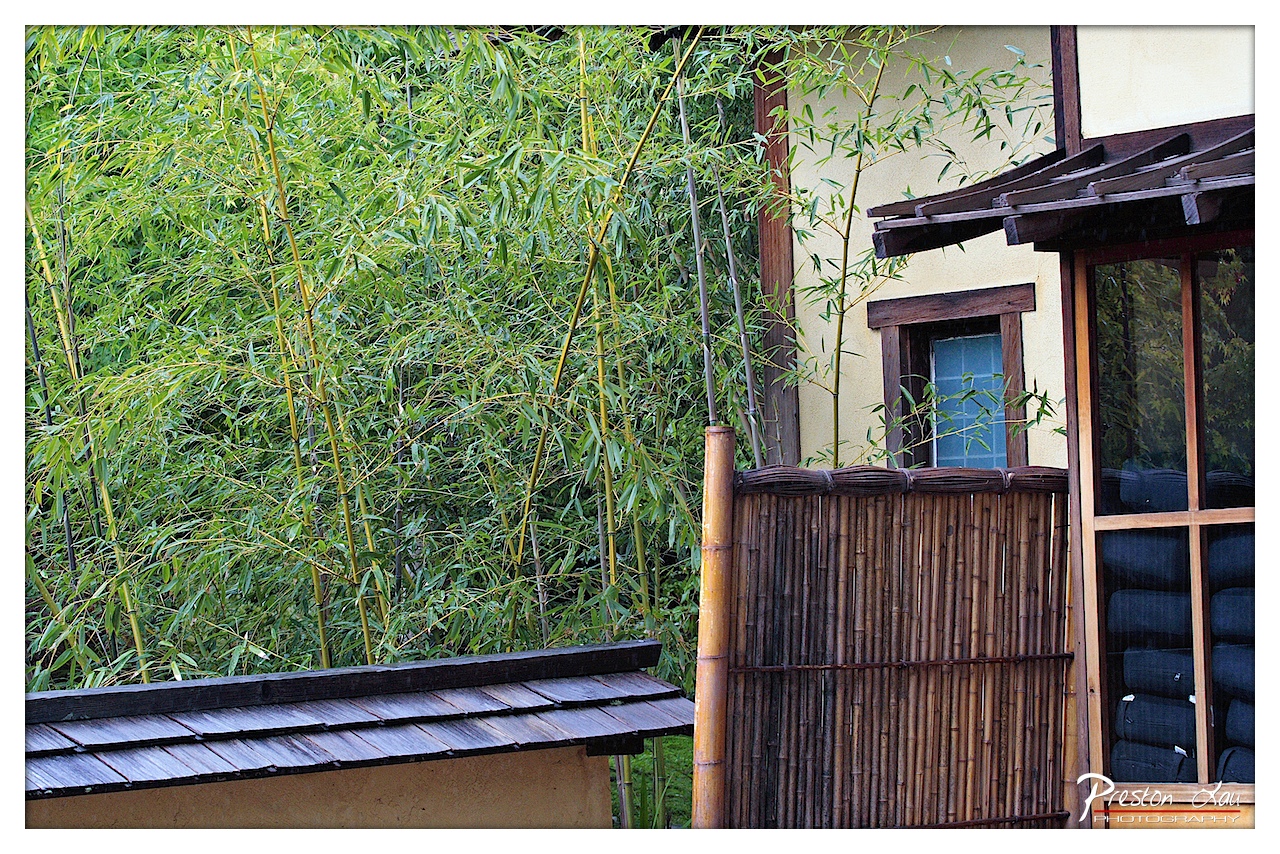

1. Overall Rating (0–10) — 7.5
This photograph captures the serene harmony of a traditional Japanese garden, where nature and architecture coexist in quiet balance. The lush bamboo grove and weathered wooden structures evoke a sense of timelessness and tranquility, while the interplay of textures and lines adds visual depth. Though the composition is strong, a slightly more deliberate framing could elevate the image from a pleasant snapshot to a compelling work of art.
2. Composition (0–10) — 7.0
The diagonal lines of the bamboo stalks and roofline create dynamic movement, guiding the eye through the frame. The placement of the bamboo screen and window balances the composition, though the left side feels slightly more dominant due to the dense foliage.
3. Lighting (0–10) — 7.5
Soft, diffused light enhances the natural textures of the bamboo and wood, casting subtle shadows that add depth without harsh contrast. The overcast conditions contribute to a calm, contemplative mood.
4. Color & Tone (0–10) — 7.0
The palette of earthy browns, muted greens, and warm yellows creates a harmonious, organic feel. The slightly cool tone of the window glass offers a subtle contrast, adding visual interest without disrupting the overall cohesion.
5. Creativity (0–10) — 7.5
The image successfully captures a quiet moment of cultural and natural integration, conveying a meditative atmosphere. The choice to focus on architectural details within a lush setting demonstrates a thoughtful approach to storytelling.
6. Technical Quality (0–10) — 8.0
Sharp focus across the frame reveals intricate textures in the bamboo, wood, and roof tiles. The exposure is well-balanced, preserving detail in both shadows and highlights.
7. Emotional Impact (0–10) — 8.0
The photograph evokes a deep sense of peace and introspection, inviting the viewer to step into a quiet, contemplative space. The natural setting and traditional elements combine to create a powerful emotional resonance.
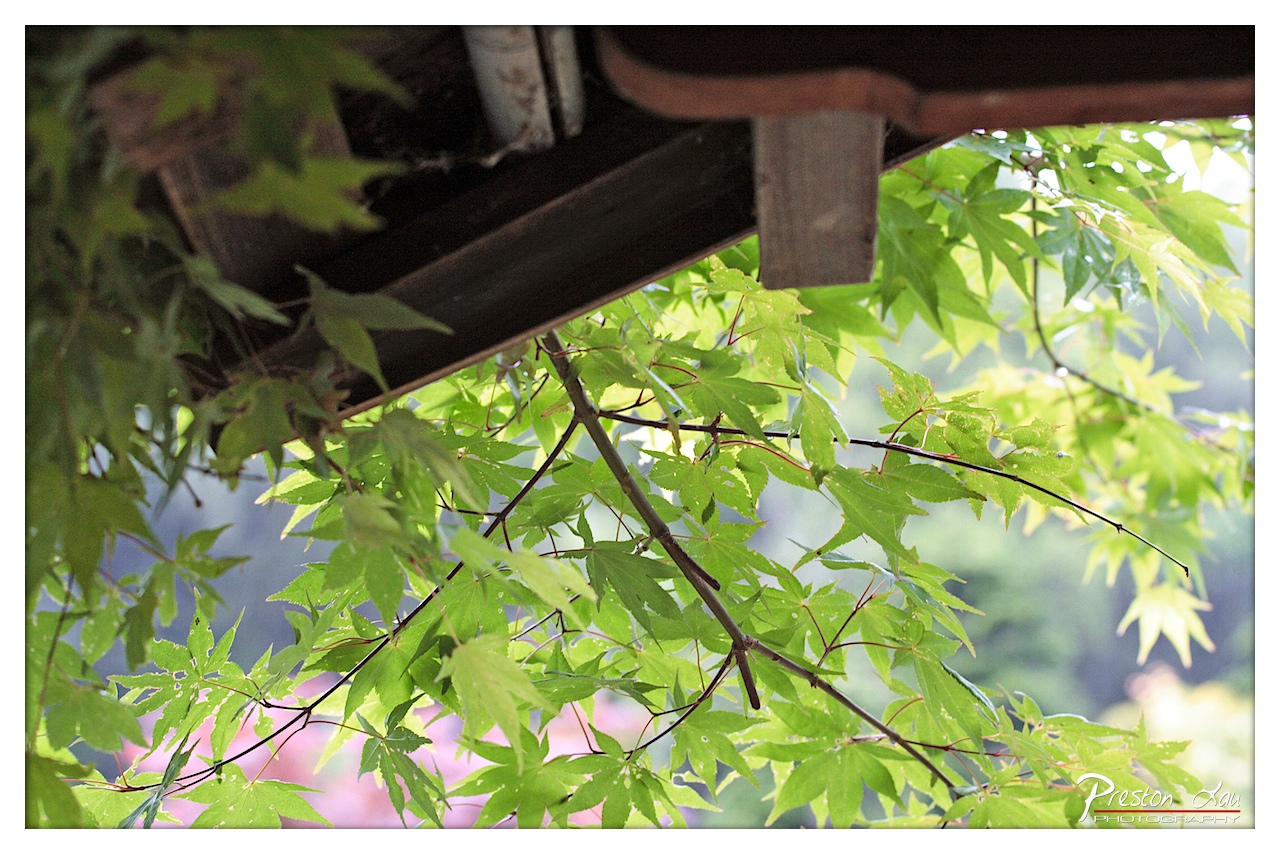

1. Overall Rating (0–10) — 7.5
This photograph captures a serene interplay between nature and architecture, where vibrant maple leaves frame the dark silhouette of a traditional wooden eave. The shallow depth of field draws attention to the delicate textures of the leaves, while the soft, diffused light enhances the tranquil mood. Though the composition is visually pleasing, a more intentional framing could elevate the image from a quiet observation to a more compelling narrative.
2. Composition (0–10) — 7.0
The diagonal lines of the branches and the overhanging eave create a dynamic yet balanced composition. The placement of the leaves in the foreground adds depth, though the slightly cluttered arrangement of the upper left edge detracts from overall harmony.
3. Lighting (0–10) — 8.0
Soft, natural light filters through the leaves, creating a gentle glow and highlighting their translucency. The diffused quality enhances the peaceful atmosphere, while the contrast between the bright leaves and the dark eave adds visual interest.
4. Color & Tone (0–10) — 8.0
The vivid green of the maple leaves contrasts beautifully with the muted browns and grays of the wooden structure. The warm, slightly soft tonal balance complements the natural subject, evoking a sense of calm and renewal.
5. Creativity (0–10) — 7.5
The perspective—looking up from beneath the eave—offers a fresh, intimate view of a familiar scene. The combination of natural elements and architectural lines suggests a thoughtful connection between human-made structures and the surrounding environment.
6. Technical Quality (0–10) — 8.0
The focus is sharp on the central leaves, with a smooth bokeh in the background that enhances depth. The image is clean, well-exposed, and free of distracting noise, demonstrating strong technical control.
7. Emotional Impact (0–10) — 8.0
The image evokes a sense of quiet contemplation and harmony with nature, inviting the viewer to pause and reflect. The interplay of light, texture, and form creates a meditative quality that resonates emotionally.
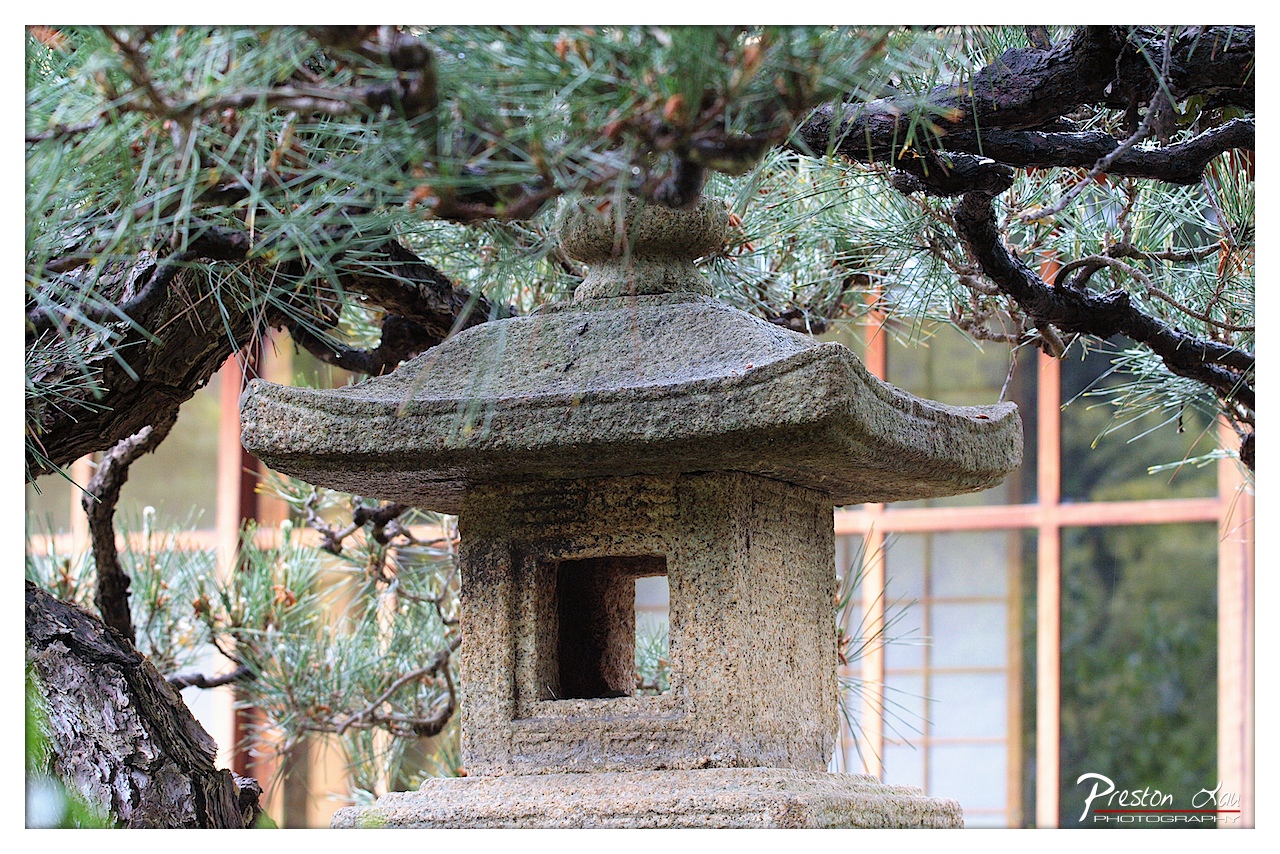

1. Overall Rating (0–10) — 7.5
This photograph captures the serene stillness of a Japanese garden, where the weathered stone lantern stands as a quiet sentinel beneath the delicate branches of a pine tree. The interplay of natural textures—rough bark, smooth stone, and fine needles—adds depth and tactile richness, while the soft focus in the background enhances the sense of calm. Though the composition is strong, a slightly more deliberate framing could elevate the visual hierarchy and draw the eye more directly to the lantern’s subtle details.
2. Composition (0–10) — 7.0
The lantern is centered with natural framing from the overhanging branches, creating a balanced and harmonious composition. The diagonal lines of the pine limbs guide the eye toward the subject, though the lower-left tree trunk slightly disrupts the symmetry.
3. Lighting (0–10) — 7.5
Soft, diffused daylight evenly illuminates the scene, highlighting the texture of the stone without harsh shadows. The light enhances the contemplative mood, allowing the natural details of the lantern and tree to emerge with clarity.
4. Color & Tone (0–10) — 7.0
The palette is composed of earthy grays, muted greens, and warm wood tones, creating a cohesive and tranquil atmosphere. The subtle contrast between the stone and the pine needles adds visual interest without overwhelming the senses.
5. Creativity (0–10) — 7.5
The image captures a traditional subject with a sense of reverence and stillness, using natural framing and depth to suggest a narrative of quiet contemplation. The choice to include the blurred shoji screen in the background adds cultural context and layers of meaning.
6. Technical Quality (0–10) — 8.0
Sharp focus on the lantern and surrounding foliage, with a shallow depth of field that isolates the subject effectively. The image is well-exposed, with clean detail and no visible artifacts.
7. Emotional Impact (0–10) — 8.0
The photograph evokes a deep sense of peace and timelessness, inviting the viewer into a moment of quiet reflection. The combination of natural elements and cultural symbolism resonates emotionally, suggesting a connection to tradition and nature.
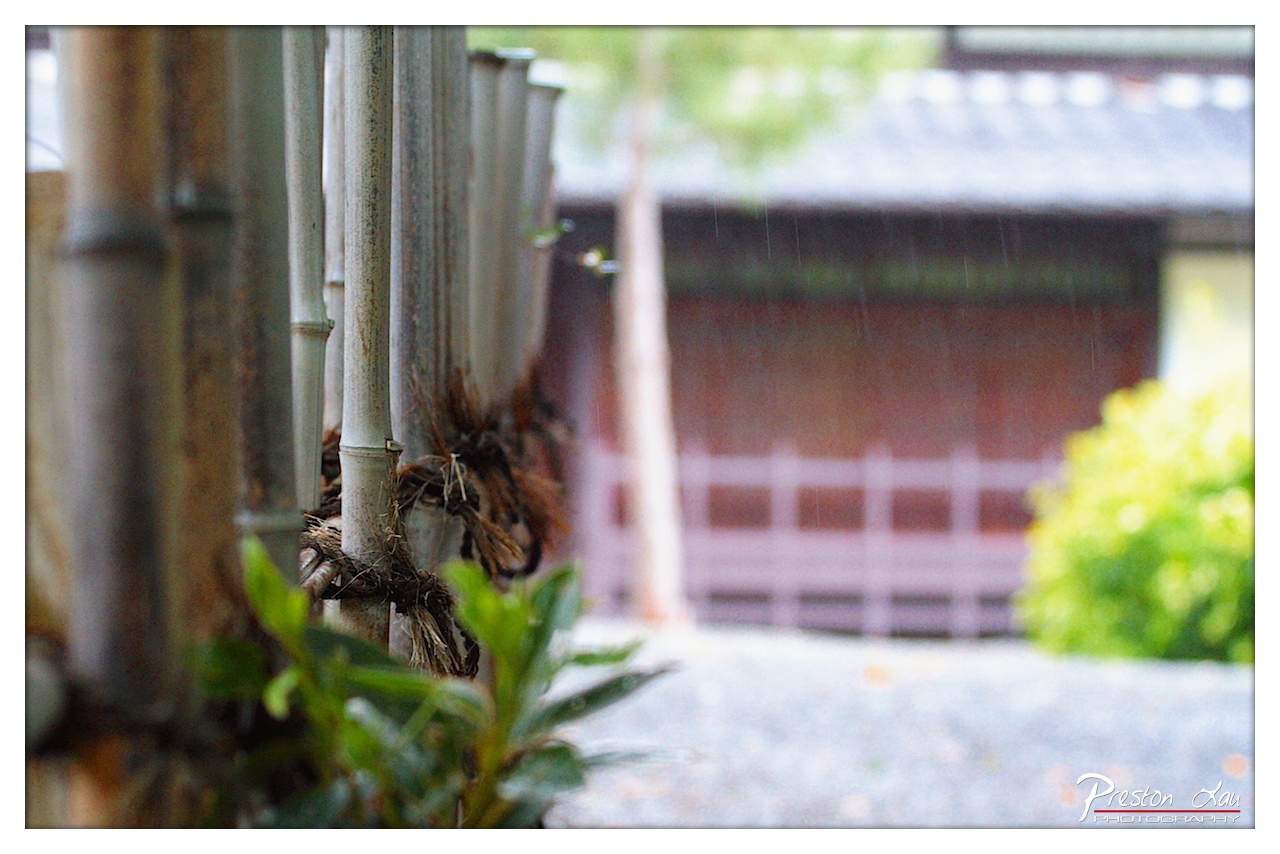

1. Overall Rating (0–10) — 7.0
This photograph captures a serene, rain-drenched moment in a traditional Japanese garden, where the interplay of texture and atmosphere evokes a sense of quiet contemplation. The shallow depth of field draws focus to the weathered bamboo and the soft blur of falling rain, creating a meditative mood. While the image is visually poetic, its subdued palette and lack of a strong focal point slightly diminish its overall impact.
2. Composition (0–10) — 6.5
The diagonal arrangement of the bamboo poles guides the eye into the frame, creating a sense of depth. However, the off-center placement and soft focus in the background result in a composition that feels more observational than intentional.
3. Lighting (0–10) — 6.0
The diffused, overcast light enhances the tranquil mood, softening edges and minimizing harsh shadows. The rain streaks add a subtle dynamic quality, though the lighting remains flat and uniform, lacking dramatic contrast.
4. Color & Tone (0–10) — 6.5
The muted greens and grays dominate the palette, with a soft warm accent in the background that prevents the image from feeling monotonous. The tonal range is narrow, which reinforces the calmness but reduces visual energy.
5. Creativity (0–10) — 7.0
The use of shallow focus and rain as a narrative element demonstrates a thoughtful approach to storytelling. The image succeeds in capturing a fleeting, atmospheric moment, though it leans more toward mood than originality.
6. Technical Quality (0–10) — 7.5
The focus is precisely placed on the bamboo in the foreground, with clean detail and minimal noise. The background blur is smooth and intentional, indicating strong technical control.
7. Emotional Impact (0–10) — 7.5
The image evokes a deep sense of calm and introspection, inviting the viewer to pause and reflect. The combination of rain, texture, and soft focus creates a quiet emotional resonance that lingers.
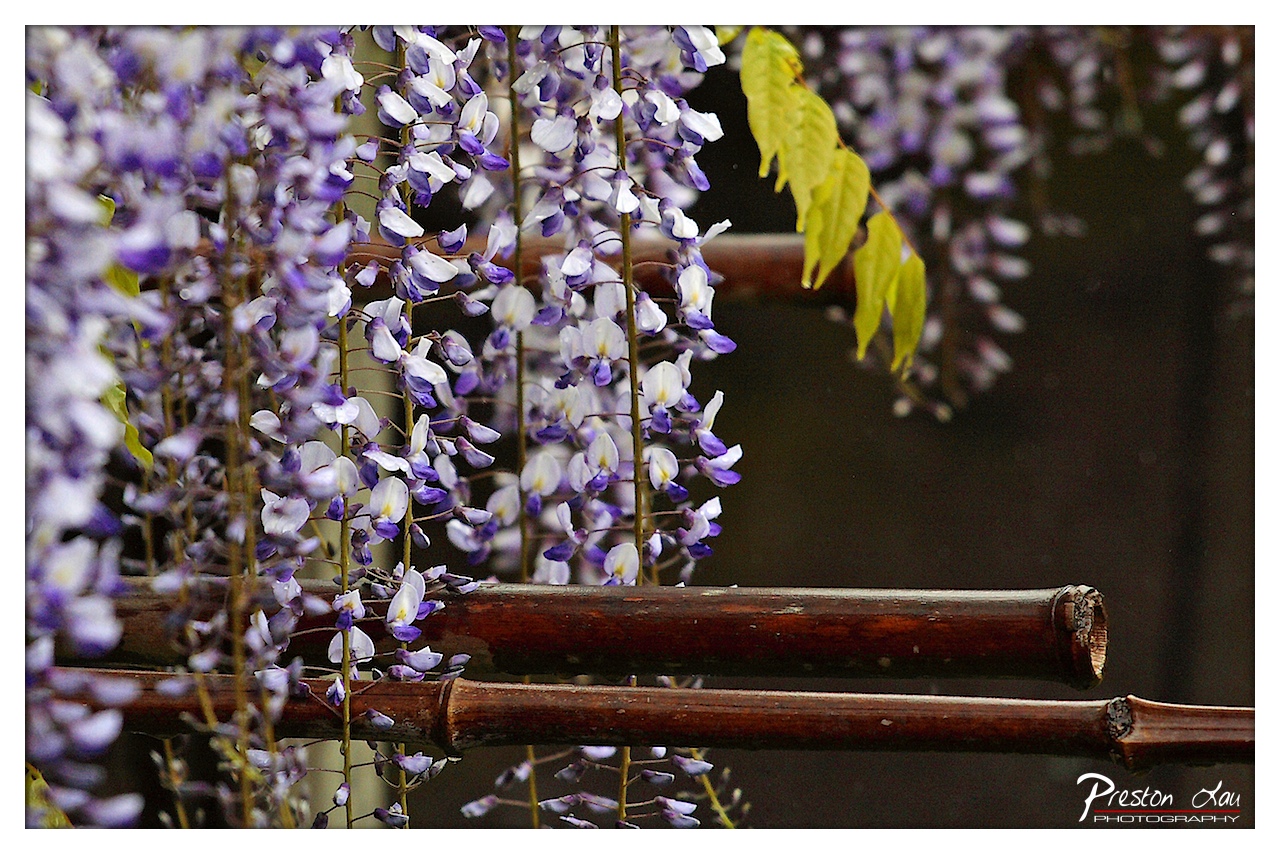

1. Overall Rating (0–10) — 8.0
This photograph captures the delicate grace of wisteria in full bloom, with a soft, dreamlike quality that evokes the quiet beauty of spring. The interplay between the cascading purple and white blossoms and the warm, weathered bamboo railing creates a harmonious balance between nature and human craftsmanship. While the composition is rich in texture and mood, a slightly more intentional focus on the floral arrangement might further elevate its visual impact.
2. Composition (0–10) — 8.0
The diagonal sweep of the wisteria and the horizontal lines of the bamboo create a dynamic yet balanced frame. The placement of the blossoms on the left draws the eye naturally, while the out-of-focus background provides depth without distraction.
3. Lighting (0–10) — 7.5
Soft, diffused light enhances the gentle textures of the petals and the grain of the bamboo, lending a calm, atmospheric quality. The shadows are subtle and well-integrated, avoiding harshness while preserving detail.
4. Color & Tone (0–10) — 8.5
The palette of purples, whites, and earthy browns is harmonious and evocative, with the bright green leaves providing a subtle but effective contrast. The tonal range is rich and well-balanced, enhancing the natural elegance of the scene.
5. Creativity (0–10) — 8.0
The photographer has captured a classic botanical subject with a thoughtful, almost painterly approach. The use of shallow depth of field and the juxtaposition of natural and man-made elements lend the image a contemplative, artistic quality.
6. Technical Quality (0–10) — 8.5
Sharp focus on the central cluster of flowers, with a smooth bokeh in the background, demonstrates strong control over depth of field. The image is clean, well-exposed, and free of distracting artifacts.
7. Emotional Impact (0–10) — 8.5
The photograph evokes a sense of tranquility and renewal, inviting the viewer to pause and appreciate the fleeting beauty of seasonal bloom. The interplay of light, color, and texture creates a deeply resonant and serene mood.
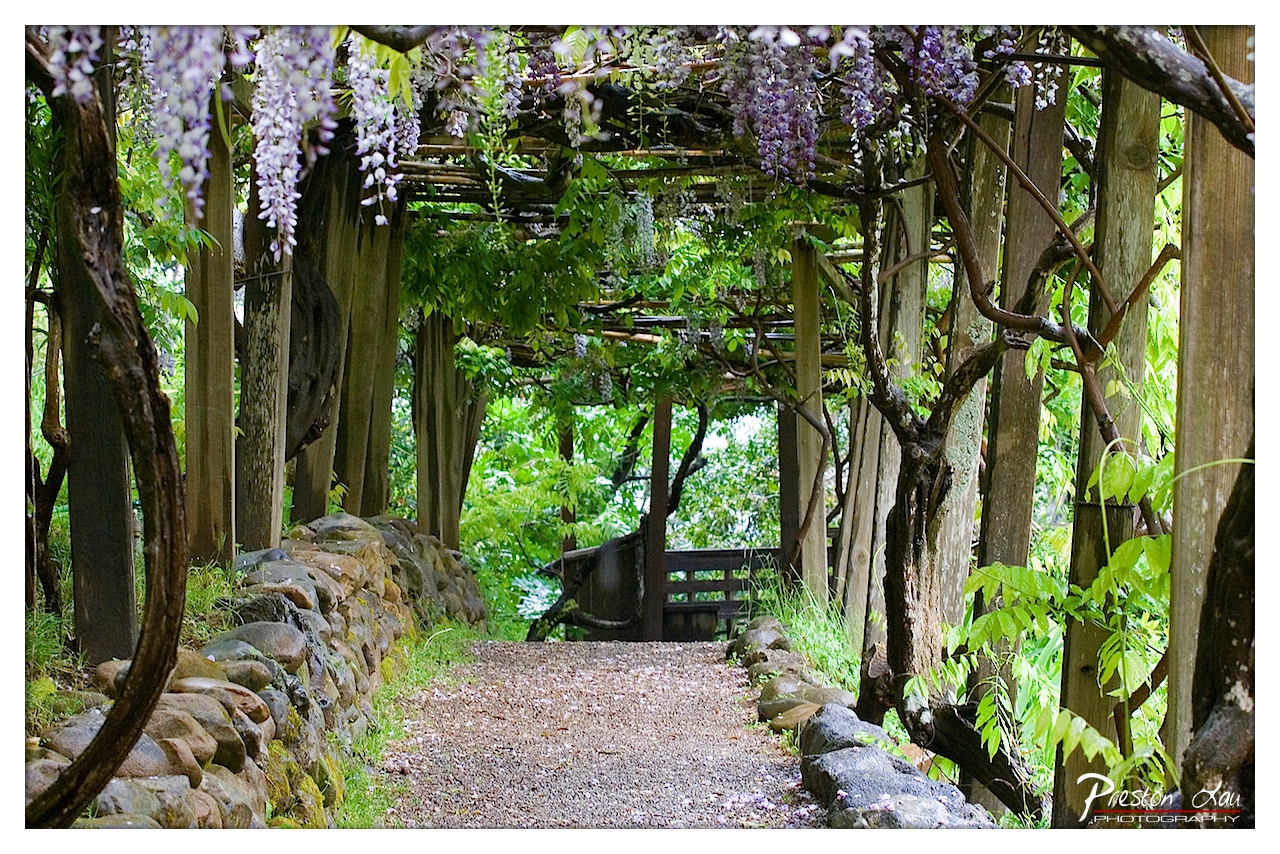

1. Overall Rating (0–10) — 8.0
This photograph captures a serene, immersive passage through a wisteria-covered arbor, where nature’s soft textures and layered greenery evoke a sense of quiet contemplation. The interplay of light filtering through the blossoms and the natural stone path creates a timeless, almost cinematic atmosphere. While the composition is strong, the image’s quiet beauty is slightly diminished by a lack of dramatic contrast, holding it just short of transcendent.
2. Composition (0–10) — 8.5
The pathway leads the eye naturally into the frame, creating depth and inviting exploration. The arbor’s arching structure frames the scene beautifully, while the asymmetrical stone wall adds visual interest and grounding.
3. Lighting (0–10) — 7.5
Soft, diffused light filters through the canopy, enhancing the dreamy mood and highlighting the delicate wisteria blooms. The gentle shadows add dimension without overpowering the scene.
4. Color & Tone (0–10) — 8.0
The palette is rich with varying greens and soft purples, creating a harmonious and naturalistic tone. The subtle contrast between the vibrant blossoms and the muted stone and wood enhances visual depth.
5. Creativity (0–10) — 8.0
The image successfully captures a moment of tranquil beauty, using natural elements to craft a narrative of passage and renewal. The choice to focus on the interplay between architecture and nature demonstrates thoughtful artistic intent.
6. Technical Quality (0–10) — 8.5
Sharp focus throughout the frame, clean detail in the blossoms and textures, and balanced exposure contribute to a technically strong image.
7. Emotional Impact (0–10) — 8.5
The photograph evokes a deep sense of peace and nostalgia, drawing the viewer into a moment of quiet escape. The lush, enveloping greenery and soft light generate a strong emotional resonance, making the scene feel both intimate and expansive.
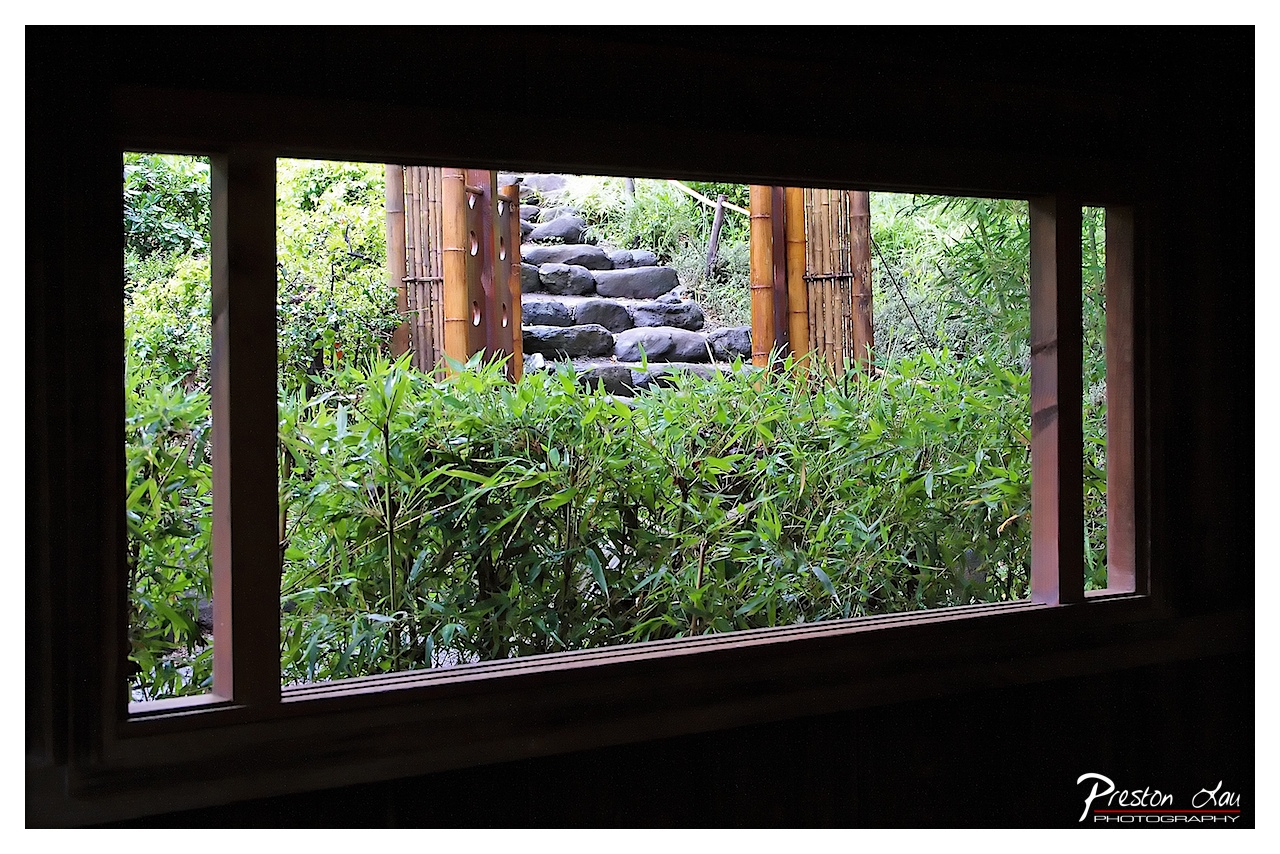

1. Overall Rating (0–10) — 8.0
This photograph captures the quiet harmony of a traditional Japanese garden, viewed through a dark wooden window frame that frames the scene like a living painting. The contrast between the shadowed interior and the sunlit greenery enhances the sense of stillness and contemplation, evoking a meditative calm. While the composition is strong and the mood deeply atmospheric, the image’s restraint—both in color and narrative—keeps it from transcending into the realm of the sublime.
2. Composition (0–10) — 8.5
The window frame acts as a natural border, creating a layered, framed view that draws the eye toward the stone path and bamboo grove. The vertical lines of the bamboo and the horizontal sweep of the foliage create visual rhythm, while the slightly off-center placement of the stone steps adds subtle asymmetry, enhancing the organic feel.
3. Lighting (0–10) — 7.5
Natural light illuminates the garden with soft, diffused brightness, highlighting the textures of the bamboo and stones while casting the interior in deep shadow. The contrast emphasizes the transition from inside to outside, enhancing depth and mood without creating harsh highlights.
4. Color & Tone (0–10) — 8.0
The palette is dominated by rich, saturated greens and earthy browns, creating a natural and cohesive tonal harmony. The dark frame and shadows add depth and contrast, allowing the vibrant foliage to stand out without appearing overexposed.
5. Creativity (0–10) — 8.5
The use of the window as a framing device is both intentional and poetic, transforming a simple garden view into a contemplative narrative. The composition suggests a moment of pause, inviting the viewer to step into the space mentally, echoing the traditional Japanese aesthetic of wabi-sabi and seijaku.
6. Technical Quality (0–10) — 8.5
The image is sharp and well-focused, with fine detail visible in the bamboo leaves and stone textures. The exposure is balanced, preserving detail in both the bright exterior and the dark interior, and the depth of field is appropriately controlled.
7. Emotional Impact (0–10) — 8.5
The photograph evokes a profound sense of peace and introspection, as if the viewer is standing at the threshold between the inner world and the natural one. The stillness of the scene and the quiet beauty of the garden invite contemplation, creating a deeply resonant emotional experience.
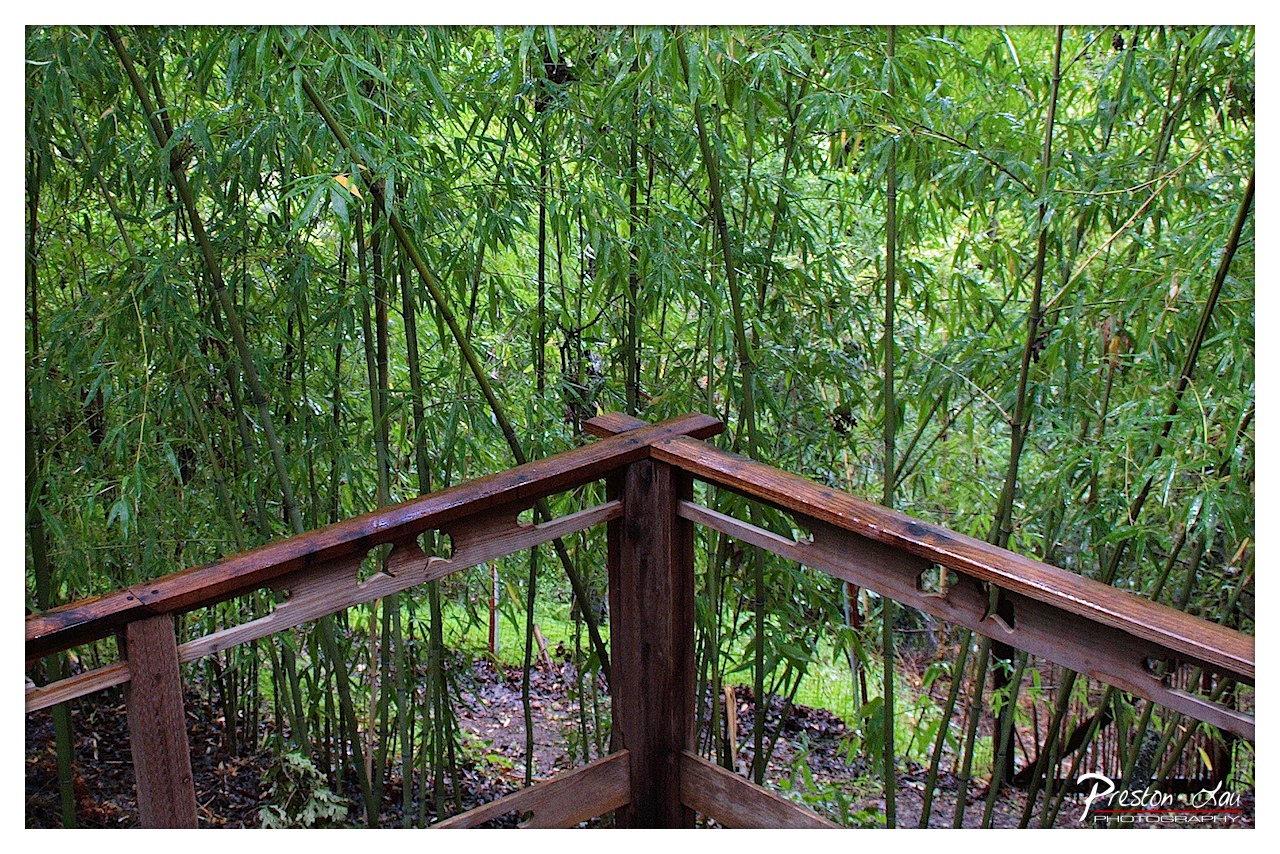

1. Overall Rating (0–10) — 7.5
This photograph captures the serene stillness of a bamboo grove, with the wooden railing framing the lush greenery like a natural window into a tranquil sanctuary. The interplay between the man-made structure and the organic chaos of the bamboo creates a contemplative mood, inviting the viewer to step into the quiet. While the image is visually rich and atmospheric, its emotional resonance is slightly muted by a lack of dynamic contrast and a somewhat flat tonal range.
2. Composition (0–10) — 7.0
The diagonal line of the wooden railing leads the eye into the frame, creating a sense of depth and guiding attention toward the dense bamboo. The framing feels intentional, with the corner of the railing anchoring the image and providing a structural counterpoint to the organic chaos behind it. However, the composition is slightly overbalanced toward the right, and a tighter crop could enhance focus and intimacy.
3. Lighting (0–10) — 6.0
The lighting is soft and diffused, likely from an overcast sky, which evenly illuminates the scene without harsh shadows. This contributes to the calm mood, but it also results in a somewhat flat exposure, reducing the visual depth and texture in the bamboo leaves. A subtle directional light could have added dimension and drama.
4. Color & Tone (0–10) — 7.0
The palette is dominated by rich, saturated greens, with the warm brown of the wooden railing providing a complementary contrast. The colors feel natural and cohesive, though the overall tone leans slightly cool, giving the image a subdued, almost melancholic quality. A touch more warmth in the highlights could have enhanced the sense of life and vibrancy in the foliage.
5. Creativity (0–10) — 7.5
The photographer has effectively used the railing as a compositional device to frame the natural world, creating a dialogue between human craftsmanship and nature’s abundance. The choice to capture the scene from a slightly elevated vantage point adds a sense of immersion and contemplation. While not radically original, the image succeeds in evoking a meditative, almost poetic atmosphere.
6. Technical Quality (0–10) — 8.0
The image is sharp and well-focused, with fine detail visible in both the wooden rail and the bamboo stalks. The depth of field is appropriate, keeping the railing in focus while allowing the background to soften slightly, enhancing the sense of depth. The exposure is balanced, with no obvious over- or underexposed areas, and the watermark is unobtrusive.
7. Emotional Impact (0–10) — 7.0
The photograph evokes a sense of peace and solitude, inviting quiet reflection. The viewer is drawn into a secluded, almost sacred space where nature and structure coexist harmoniously. While the emotional pull is strong, it is restrained by the image’s subdued lighting and lack of dynamic contrast, keeping the experience more contemplative than deeply moving.
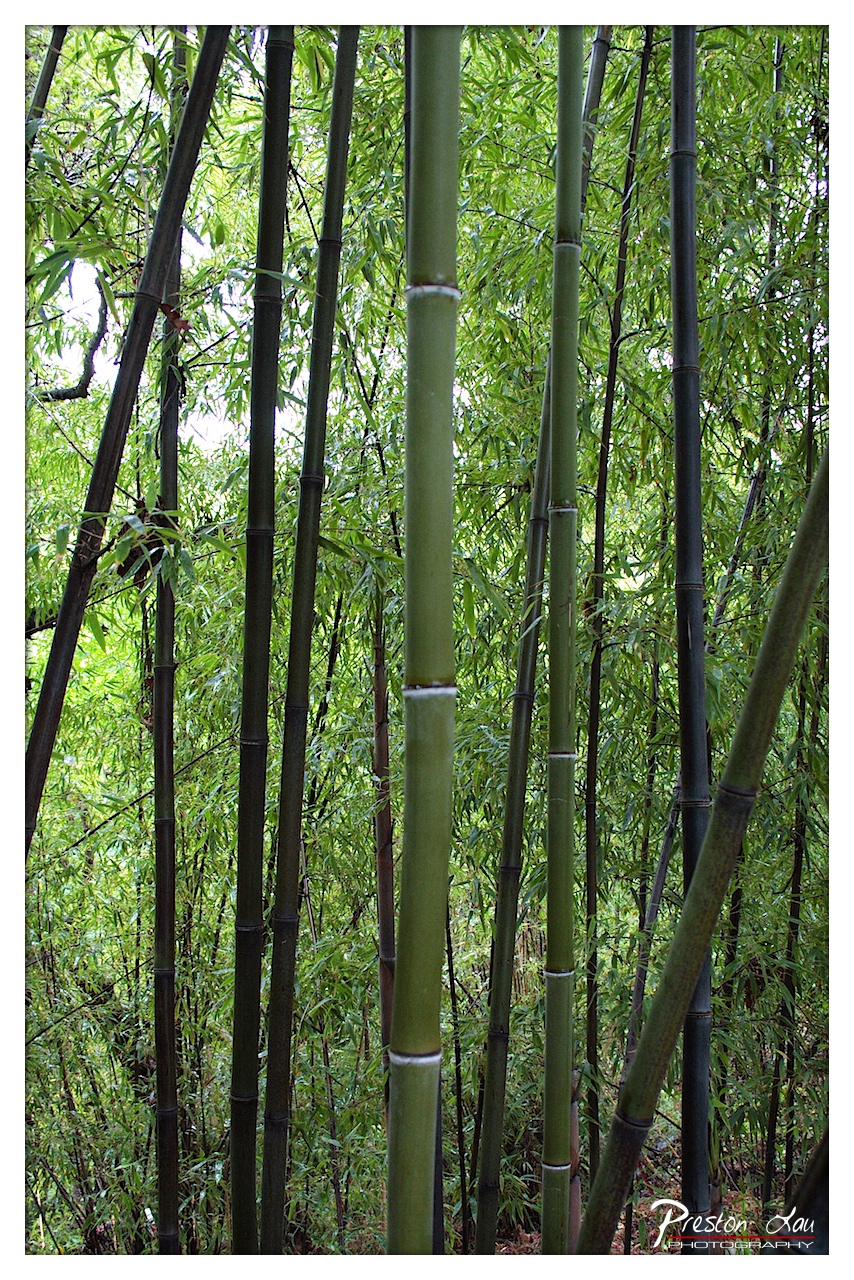

1. Overall Rating (0–10) — 7.0
This photograph captures the serene density of a bamboo grove, where vertical lines create a natural rhythm and the interplay of light and shadow adds depth. The lush greenery evokes a sense of calm and seclusion, though the composition feels slightly overgrown and lacks a clear focal point. With tighter framing and more intentional lighting, the image could feel more immersive and artistically cohesive.
2. Composition (0–10) — 6.0
The vertical alignment of bamboo stalks creates a strong directional flow, but the lack of a dominant subject or leading line results in a visually busy scene. A more deliberate arrangement of elements would enhance balance and guide the viewer’s eye.
3. Lighting (0–10) — 6.5
Natural daylight filters through the canopy, creating soft highlights and gentle shadows that emphasize the texture of the bamboo. However, the light is uneven, with some areas overexposed and others lost in shadow, slightly diminishing overall clarity.
4. Color & Tone (0–10) — 7.5
The palette is rich in varying shades of green, from deep forest tones to bright, sun-kissed leaves. The contrast between light and dark greens enhances depth, and the natural tonal range supports the tranquil mood of the scene.
5. Creativity (0–10) — 7.0
The image offers a fresh perspective on a common natural subject, using the repetition of bamboo culms to create visual harmony. While not groundbreaking, it conveys a quiet beauty that invites contemplation.
6. Technical Quality (0–10) — 7.5
The photograph is sharp and detailed, with clear focus on the central bamboo stalks. The watermark is subtle and does not distract, indicating careful post-processing and attention to detail.
7. Emotional Impact (0–10) — 7.0
The image evokes a sense of peace and solitude, drawing the viewer into a quiet, secluded woodland. The immersive quality of the grove creates a meditative atmosphere, though the lack of human presence keeps the emotional connection at a distance.
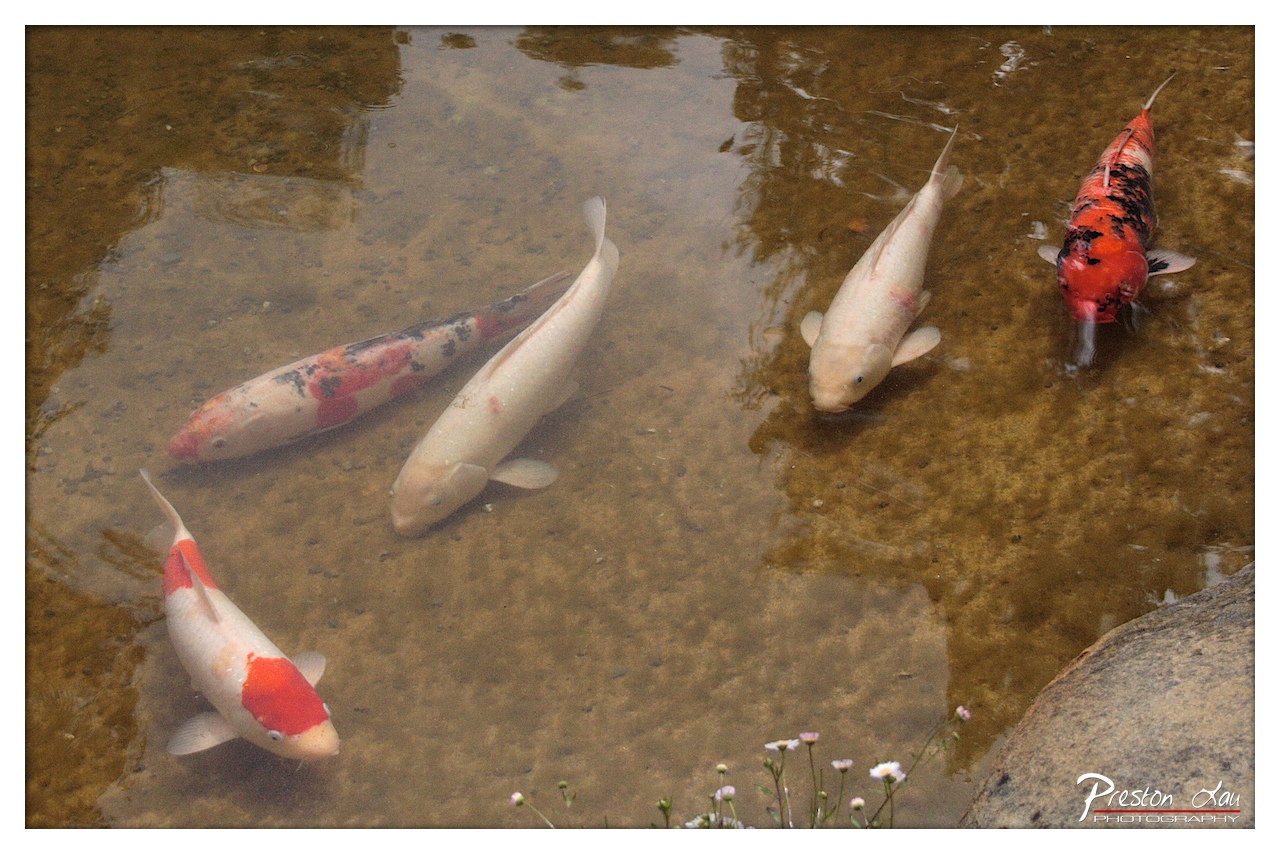

1. Overall Rating (0–10) — 7.0
This photograph captures a serene moment in a koi pond, where the graceful movement of the fish is softened by the gentle ripples of the water. The composition balances natural detail with a contemplative mood, enhanced by the subtle interplay of light and reflection. While the image is visually calming and rich in texture, it lacks a strong focal point, and the slightly murky water tempers the vibrancy of the koi’s colors.
2. Composition (0–10) — 6.5
The koi are scattered across the frame, creating a sense of natural movement, but the lack of a clear focal point dilutes visual impact. The inclusion of flowers in the foreground adds depth, but their small scale limits their compositional influence.
3. Lighting (0–10) — 6.0
Natural daylight illuminates the scene evenly, but the overcast quality results in flat, diffused light that diminishes contrast and shadow definition. Reflections on the water surface add texture, but the overall lighting lacks drama or directional emphasis.
4. Color & Tone (0–10) — 6.5
The palette is warm and earthy, with the reddish-orange and white of the koi standing out against the brown, muddied water. While the colors are harmonious, their muted saturation reduces visual punch, and the water’s slight murkiness softens the contrast between fish and background.
5. Creativity (0–10) — 6.0
The image presents a peaceful, observational view of koi in their habitat, with a focus on naturalism rather than artistic manipulation. The inclusion of delicate flowers in the foreground introduces a touch of poetic contrast, but the concept remains straightforward and unchallenging.
6. Technical Quality (0–10) — 7.5
The image is sharp and well-focused, with clean details visible in the koi’s scales and the water’s surface. The exposure is balanced, and the watermark is discreet, maintaining professionalism.
7. Emotional Impact (0–10) — 7.0
The photograph evokes a sense of tranquility and quiet contemplation, inviting the viewer to pause and reflect on the gentle rhythm of life in the pond. The stillness of the water and the slow movement of the fish create a meditative atmosphere, though the lack of dramatic lighting or color limits its emotional intensity.
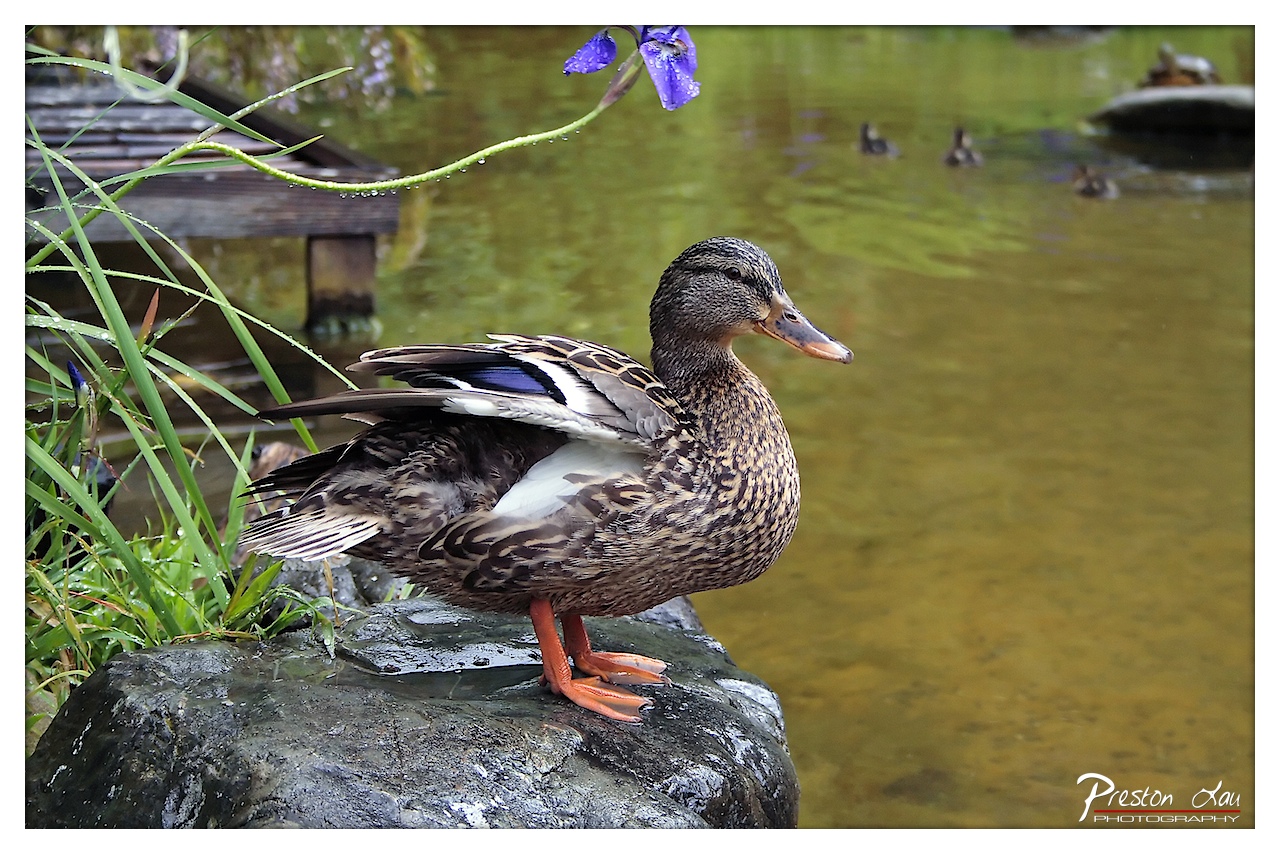

1. Overall Rating (0–10) — 7.5
This photograph captures a serene moment in a natural setting, where a mallard duck rests gracefully on a wet rock, surrounded by lush greenery and a tranquil pond. The composition is balanced and inviting, with the vibrant purple iris adding a striking contrast to the earthy tones of the duck and the water. While the image excels in capturing the quiet beauty of the scene, a slightly more intentional focus on the duck’s expression could deepen the emotional connection.
2. Composition (0–10) — 8.0
The duck is placed off-center, following the rule of thirds, which draws the eye naturally while allowing space for the surrounding environment. The diagonal line of the iris adds dynamic tension, guiding the viewer from the foreground into the depth of the scene. The blurred background enhances focus on the main subject, creating a layered and well-balanced frame.
3. Lighting (0–10) — 7.0
Soft, diffused light evenly illuminates the scene, minimizing harsh shadows and highlighting the textures of the duck’s feathers and the damp rock. The light appears to be from an overcast sky, which contributes to the calm, muted mood. While the lighting is natural and flattering, a touch of directional sunlight could add more dimension to the duck’s plumage.
4. Color & Tone (0–10) — 8.0
The palette is rich and harmonious, with the warm brown and white tones of the duck complementing the green water and foliage. The deep purple of the iris provides a vivid pop of color that anchors the composition and adds visual interest. The overall tonal balance is warm and cohesive, enhancing the natural atmosphere of the scene.
5. Creativity (0–10) — 7.5
The photographer captures a quiet, everyday moment with a sense of elegance and intention. The inclusion of the purple iris introduces a poetic element, transforming a simple wildlife scene into a more narrative and aesthetically layered image. The focus on texture and color demonstrates a thoughtful approach to nature photography.
6. Technical Quality (0–10) — 8.5
The image is sharp and well-focused on the duck, with fine detail visible in the feathers and the wet surface of the rock. The depth of field is skillfully managed, keeping the subject crisp while softly blurring the background. The exposure is balanced, with no areas of over- or underexposure, and the white balance accurately represents the natural colors of the environment.
7. Emotional Impact (0–10) — 8.0
The photograph evokes a sense of peace and stillness, inviting the viewer to pause and appreciate the quiet beauty of nature. The duck’s calm posture and the gentle surroundings create a meditative mood, while the presence of the iris adds a touch of whimsy and wonder. The image resonates emotionally by capturing a fleeting moment of tranquility in the wild.
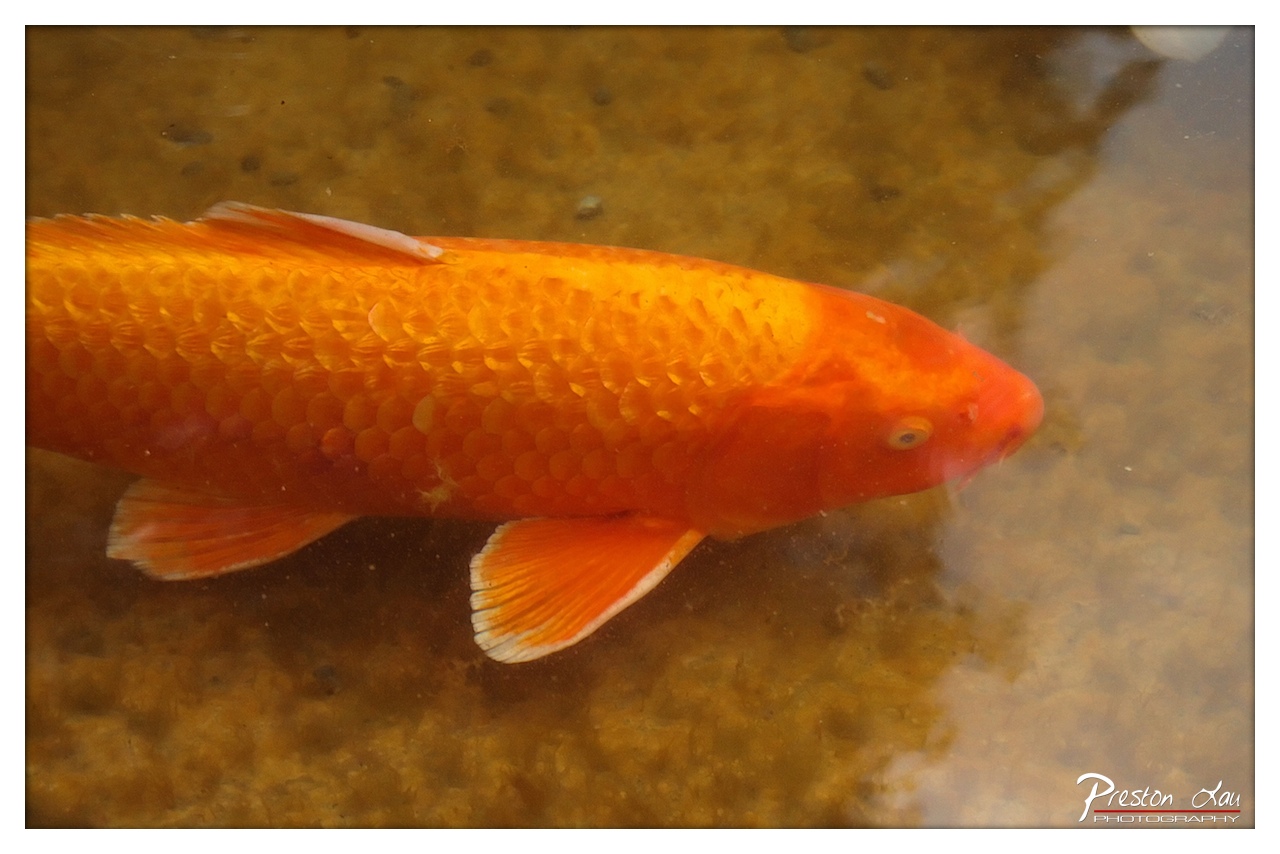

1. Overall Rating (0–10) — 7.0
This photograph captures the serene grace of a golden koi gliding through calm water, its vibrant scales catching the light like molten metal. The warm, earthy tones of the pond floor create a harmonious backdrop, enhancing the fish’s luminous presence. While the image succeeds in conveying tranquility and natural beauty, its slightly murky water and soft focus limit the visual clarity, preventing it from achieving a truly polished aesthetic.
2. Composition (0–10) — 7.0
The koi is positioned diagonally across the frame, guiding the eye smoothly from left to right. The balance between the subject and the visible pond floor creates a sense of depth, though the right side feels slightly underexposed, creating an uneven visual weight.
3. Lighting (0–10) — 6.5
Soft, diffused lighting enhances the golden hues of the koi without harsh glare, creating a gentle glow on its scales. However, the overall illumination lacks punch, resulting in a somewhat flat appearance that diminishes the three-dimensional quality of the fish.
4. Color & Tone (0–10) — 7.5
The warm orange and amber palette is rich and cohesive, with the koi’s color standing out against the subdued brown tones of the pond. The slight sepia cast adds a vintage warmth, enhancing the tranquil mood.
5. Creativity (0–10) — 7.0
The image presents a simple yet effective moment of natural beauty, capturing the quiet elegance of a koi in its environment. While not groundbreaking, it conveys a meditative stillness that invites contemplation.
6. Technical Quality (0–10) — 7.5
The focus is sharp on the koi’s body, capturing fine detail in the scales and fins. The depth of field is appropriate, though the water’s slight murkiness and minor lens flare slightly reduce overall clarity.
7. Emotional Impact (0–10) — 7.5
The photograph evokes calm and serenity, with the slow movement of the koi and the warm color tones creating a peaceful, almost hypnotic atmosphere. It connects viewers to a quiet moment of nature, stirring a sense of quiet wonder.
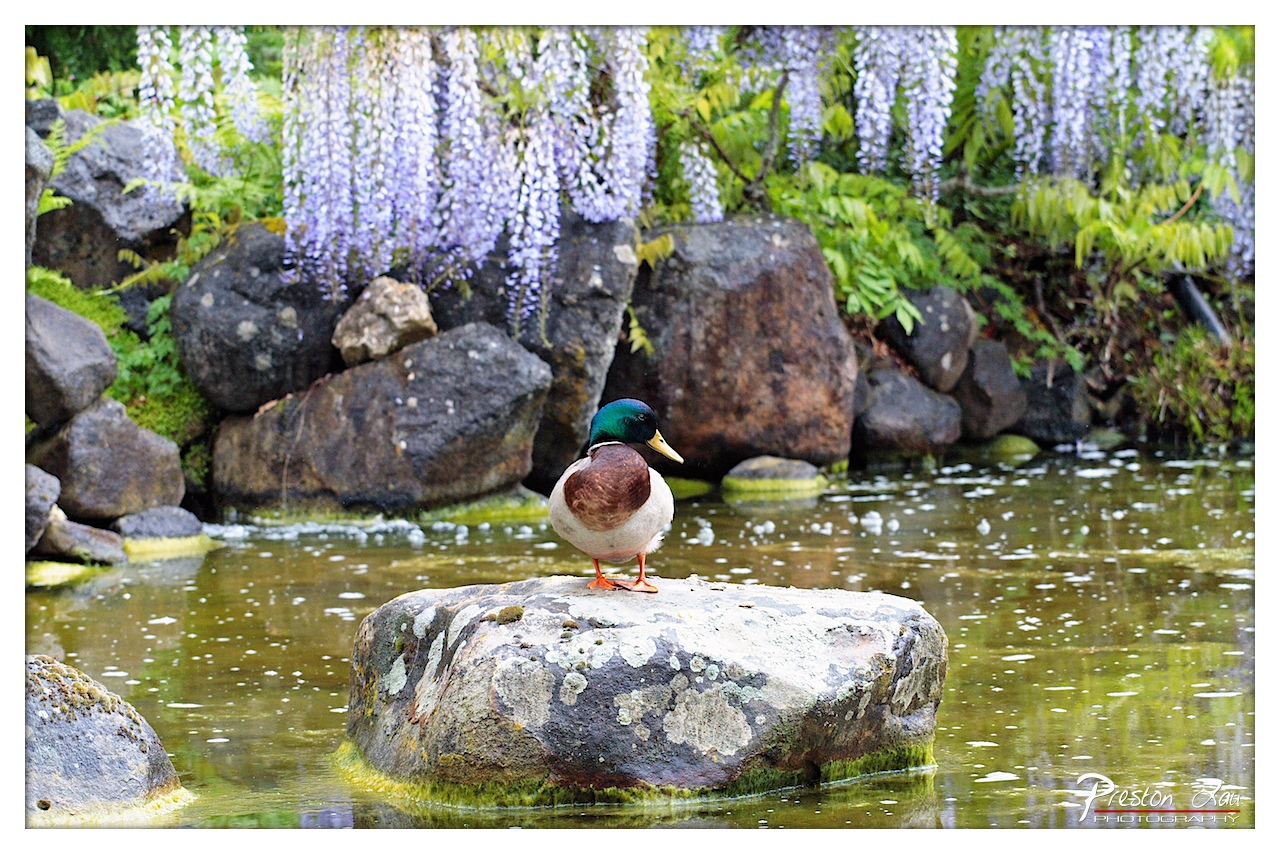

1. Overall Rating (0–10) — 8.0
This photograph captures a serene moment in a lush garden, where the vibrant presence of a mallard duck contrasts beautifully with the soft, cascading wisteria. The composition balances natural elements with a sense of quiet stillness, and the rich textures of moss, water, and flower create a visually layered scene. While the image is strong in mood and detail, it slightly lacks depth in its color saturation, holding back from full visual immersion.
2. Composition (0–10) — 8.0
The duck is centered on a prominent rock, creating a strong focal point, while the wisteria arches overhead, framing the scene naturally. The use of leading lines from the water and foliage draws the eye toward the subject, and the depth of field effectively separates the foreground from the background, enhancing focus.
3. Lighting (0–10) — 7.5
Soft, diffused light enhances the scene’s natural beauty, avoiding harsh shadows and allowing the colors to appear rich yet balanced. The lighting highlights the duck’s iridescent feathers and the delicate texture of the wisteria, contributing to the image’s tranquil mood.
4. Color & Tone (0–10) — 8.0
The palette blends cool purples and greens with the warm brown and white of the duck, creating a harmonious and natural contrast. The tones are rich and slightly saturated, giving the image a painterly quality while maintaining realism.
5. Creativity (0–10) — 8.5
The juxtaposition of the grounded duck against the ethereal wisteria creates a poetic, almost whimsical narrative. The photographer captures a fleeting moment of harmony between wildlife and cultivated nature, offering a fresh perspective on a common subject.
6. Technical Quality (0–10) — 8.5
The image is sharp and well-focused on the duck, with fine detail visible in the feathers, rock, and flowers. The depth of field is controlled effectively, and the exposure is balanced, preserving detail in both highlights and shadows.
7. Emotional Impact (0–10) — 8.0
The photograph evokes a sense of peace and wonder, inviting the viewer into a quiet corner of nature. The calm stillness of the duck and the gentle sway of the wisteria create a meditative quality, making the image emotionally resonant and memorable.
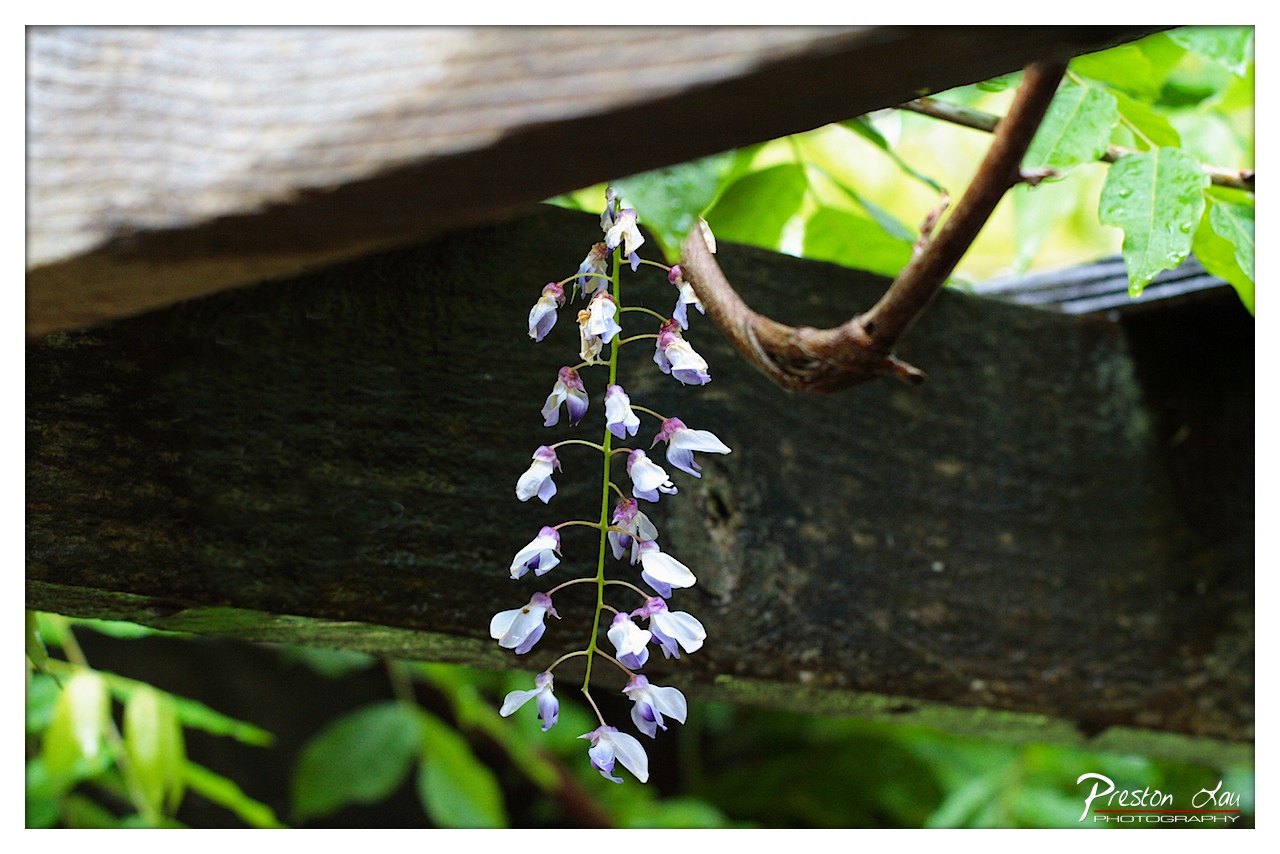

1. Overall Rating (0–10) — 7.5
This photograph captures a delicate wisteria bloom suspended beneath a weathered wooden beam, evoking a sense of quiet resilience and natural elegance. The contrast between the soft, pastel flowers and the rugged texture of the wood creates a compelling visual harmony, while the dappled light and lush greenery enhance the scene’s tranquil, garden-like atmosphere. The image feels intimate and contemplative, though slight underexposure in the background tempers its overall luminosity.
2. Composition (0–10) — 8.0
The flower cluster is well-placed along the vertical axis, drawing the eye downward with a natural flow. The diagonal wooden beam adds depth and structure, framing the subject while leading the viewer’s gaze. The soft bokeh of the green foliage in the background prevents distraction and emphasizes the central bloom.
3. Lighting (0–10) — 7.0
Natural, diffused light softly illuminates the wisteria, highlighting its delicate petals without harsh shadows. The light appears to filter through overhead leaves, creating a gentle glow that enhances the flower’s subtle colors. A slight lack of brightness in the lower portion of the frame slightly dims the scene’s overall vibrancy.
4. Color & Tone (0–10) — 7.5
The palette balances soft purples and whites of the blossoms with rich, earthy greens and deep browns of the wood and foliage. The colors are harmonious and natural, with a cool tone that complements the tranquil mood. A slight desaturation in the background tones keeps the focus on the flower, though adding a touch more warmth could elevate the scene’s inviting quality.
5. Creativity (0–10) — 7.0
The composition reflects a thoughtful interplay between nature and man-made structure, suggesting a narrative of growth and endurance. The choice to frame the flower beneath the beam gives the image a poetic, almost symbolic quality—suggesting beauty emerging from shelter or shadow. While not radically original, the approach is refined and emotionally resonant.
6. Technical Quality (0–10) — 8.5
The image is sharp and detailed, particularly in the focus on the wisteria’s petals and the texture of the wood. Depth of field is well-managed, isolating the subject effectively. The watermark is subtle and does not detract from the image. No visible noise or artifacts are present.
7. Emotional Impact (0–10) — 8.0
There is a quiet serenity in the image that invites contemplation—like a moment captured between rain and sun. The delicate flower, framed by the enduring beam, evokes feelings of fragility, resilience, and the beauty of transient life. The viewer is drawn into a peaceful, meditative space, making the image emotionally engaging and memorable.
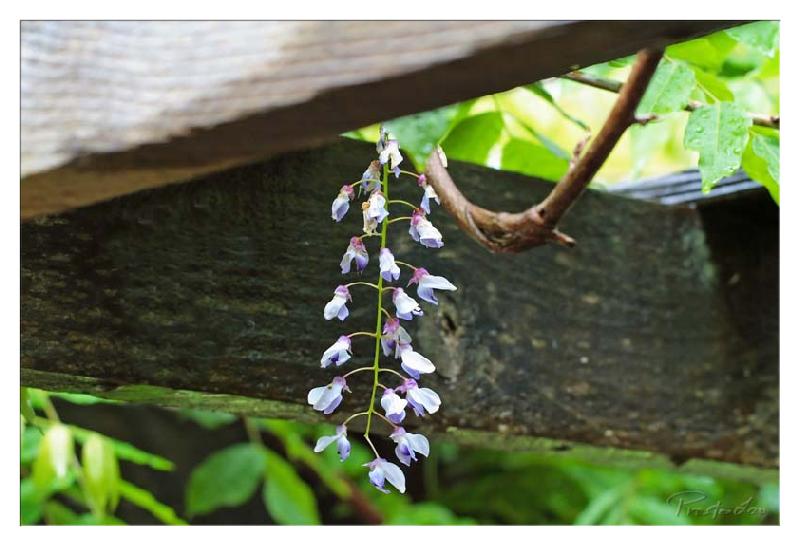

1. Overall Rating (0–10) — 7.0
This photograph captures a quiet moment of natural elegance, where the delicate cascade of wisteria blossoms contrasts beautifully with the weathered texture of aged wood. The composition draws the eye to the soft purple and white flowers, creating a sense of gentle resilience. While the image is visually pleasing and rich in detail, it could benefit from a more deliberate use of depth and lighting to heighten its emotional resonance.
2. Composition (0–10) — 7.5
The diagonal lines of the wooden beam and the downward droop of the flower cluster create a dynamic, balanced frame. The subject is well-placed off-center, allowing the natural elements to guide the viewer’s gaze organically through the image.
3. Lighting (0–10) — 6.5
Soft, diffused light enhances the natural colors of the scene without harsh shadows, though the overall exposure leans slightly flat. The light subtly highlights the texture of the wood and the translucency of the petals, contributing to a calm, understated mood.
4. Color & Tone (0–10) — 7.0
The palette is harmonious, with soft purples and whites of the blossoms set against the deep, earthy tones of the wood and lush green foliage. The color temperature is cool and natural, reinforcing the serene, outdoor atmosphere.
5. Creativity (0–10) — 7.0
The image successfully blends natural beauty with a rustic architectural element, suggesting a narrative of time and growth. While the concept is familiar, the execution feels thoughtful and evocative, with a quiet poetic quality.
6. Technical Quality (0–10) — 8.0
The focus is sharp on the wisteria, with clear detail in the petals and wood grain. The depth of field is appropriately managed, blurring the background just enough to emphasize the subject without losing context.
7. Emotional Impact (0–10) — 7.5
The image evokes a sense of peace and quiet contemplation, inviting the viewer to pause and appreciate the delicate beauty of nature in an everyday setting. The contrast between the fragile flowers and the enduring wood suggests a gentle resilience that resonates emotionally.
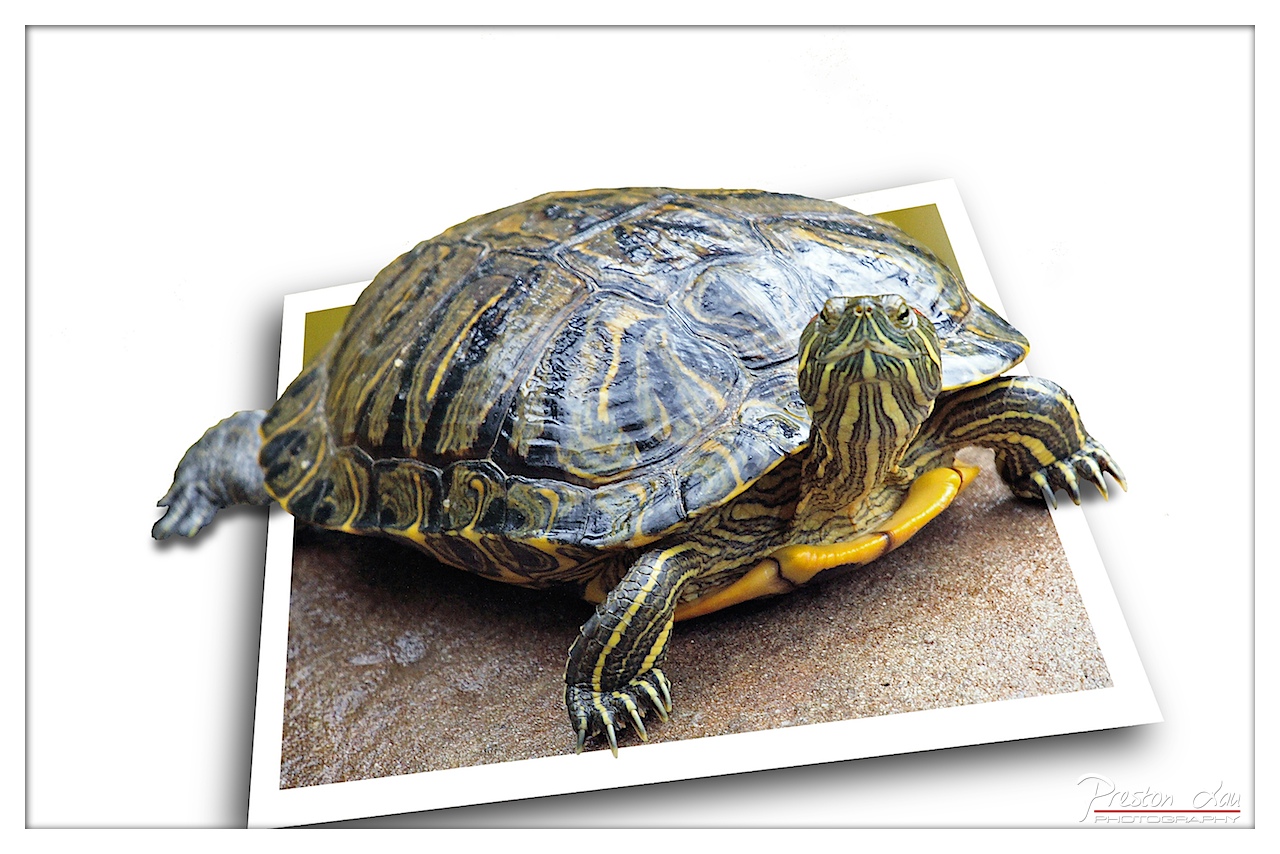

1. Overall Rating (0–10) — 7.0
This photograph presents a striking visual paradox: a lifelike turtle seemingly emerging from a printed image, creating a layered, almost surreal effect. The contrast between the organic texture of the turtle and the flat, artificial frame adds a conceptual depth, while the vibrant yellow markings on the turtle’s shell draw the eye. However, the overly clean white background and the digital manipulation of the photo's edge slightly undermine its naturalism, making it feel more like a conceptual piece than a candid wildlife capture.
2. Composition (0–10) — 7.5
The turtle is well-centered and diagonally oriented, creating a dynamic sense of movement across the frame. The layered effect of the photo within a photo adds visual interest, though the slight tilt and framing edge distract from the subject’s natural presence.
3. Lighting (0–10) — 7.0
The lighting is even and bright, highlighting the intricate patterns on the turtle’s shell and limbs. A soft shadow beneath the photo enhances the illusion of depth, though the overall lighting feels slightly artificial, possibly due to studio or post-processing adjustments.
4. Color & Tone (0–10) — 8.0
The color palette is rich and vivid, with strong contrast between the dark, patterned shell and the bright yellow accents. The warm sandy background complements the turtle’s natural tones, while the white border enhances visual separation and focus.
5. Creativity (0–10) — 8.5
The idea of a turtle emerging from a photograph is imaginative and conceptually strong, blending reality with digital artistry. This creative approach transforms a simple animal portrait into a commentary on perception and representation.
6. Technical Quality (0–10) — 8.5
The image is sharp and detailed, with excellent focus on the turtle’s shell and limbs. The edges of the photo are clean, and the watermark is unobtrusive, indicating a high level of technical control and post-processing skill.
7. Emotional Impact (0–10) — 6.5
While the image is visually engaging and thought-provoking, its conceptual nature keeps the viewer at a slight emotional distance. The juxtaposition of nature and artificiality evokes curiosity rather than deep emotional resonance.
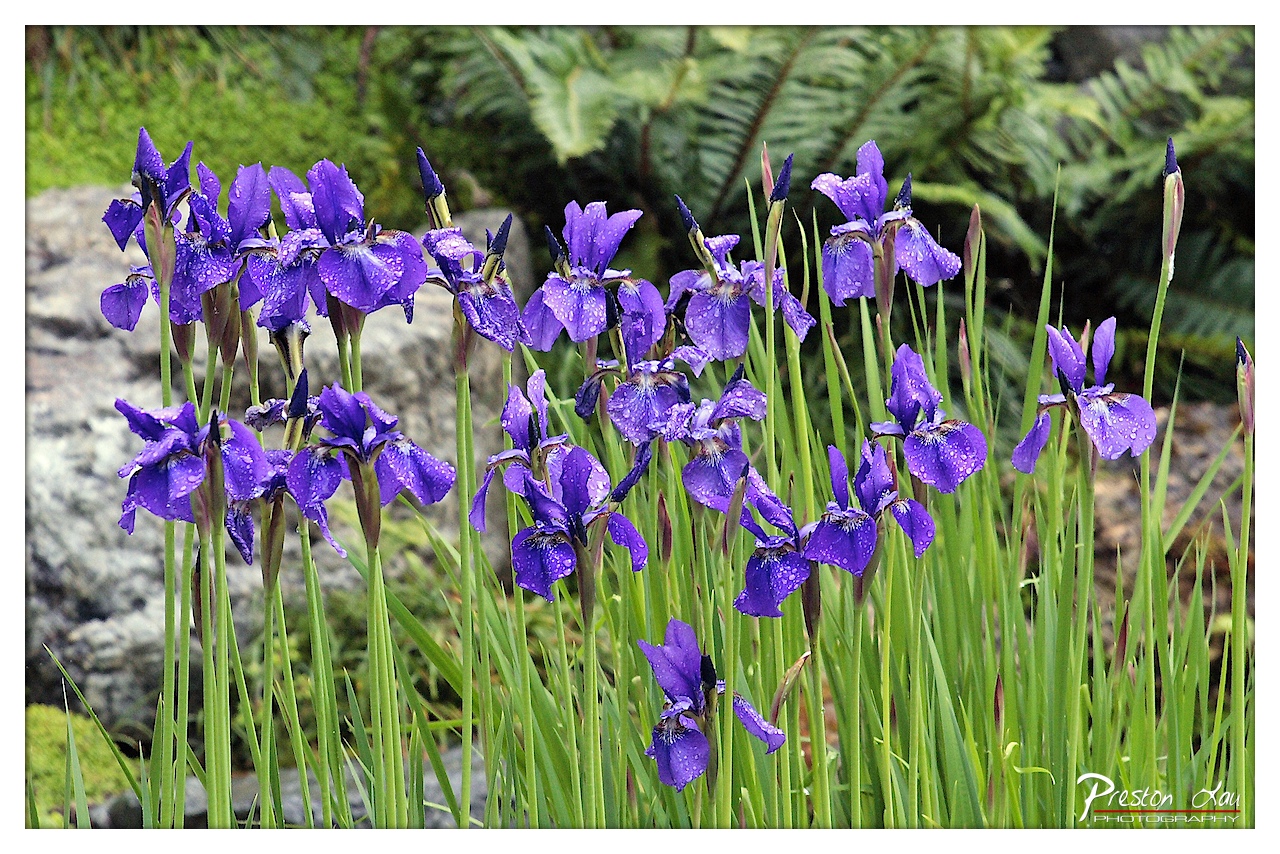

1. Overall Rating (0–10) — 7.5
This photograph captures the vibrant elegance of purple irises glistening with dew, set against a lush, verdant backdrop. The rich color contrast and delicate water droplets lend a fresh, almost luminous quality to the scene, evoking a sense of morning tranquility. While the image is visually arresting, it slightly lacks compositional refinement in the framing, which keeps it from achieving full artistic cohesion.
2. Composition (0–10) — 6.5
The subject is well-centered, but the inclusion of too much surrounding foliage and rock creates visual clutter. A tighter crop would better emphasize the irises and improve balance.
3. Lighting (0–10) — 8.0
Soft, diffused natural light enhances the delicate textures of the petals and dew, creating a gentle glow without harsh shadows. The lighting perfectly captures the freshness of a dewy morning.
4. Color & Tone (0–10) — 8.5
The deep purples of the irises pop vividly against the bright green foliage, with excellent saturation and natural tonal harmony. The color temperature enhances the scene’s cool, serene mood.
5. Creativity (0–10) — 7.0
The photographer captures a classic botanical moment with a strong eye for detail, but the approach remains conventional. The image excels in beauty rather than conceptual innovation.
6. Technical Quality (0–10) — 8.5
Sharp focus on the foreground flowers, clean depth of field, and well-managed exposure contribute to a technically polished image. The watermark is unobtrusive.
7. Emotional Impact (0–10) — 7.5
The image evokes calm and renewal, inviting the viewer to pause and appreciate nature’s quiet beauty. The freshness of the dew and the stillness of the moment create a meditative, soothing effect.
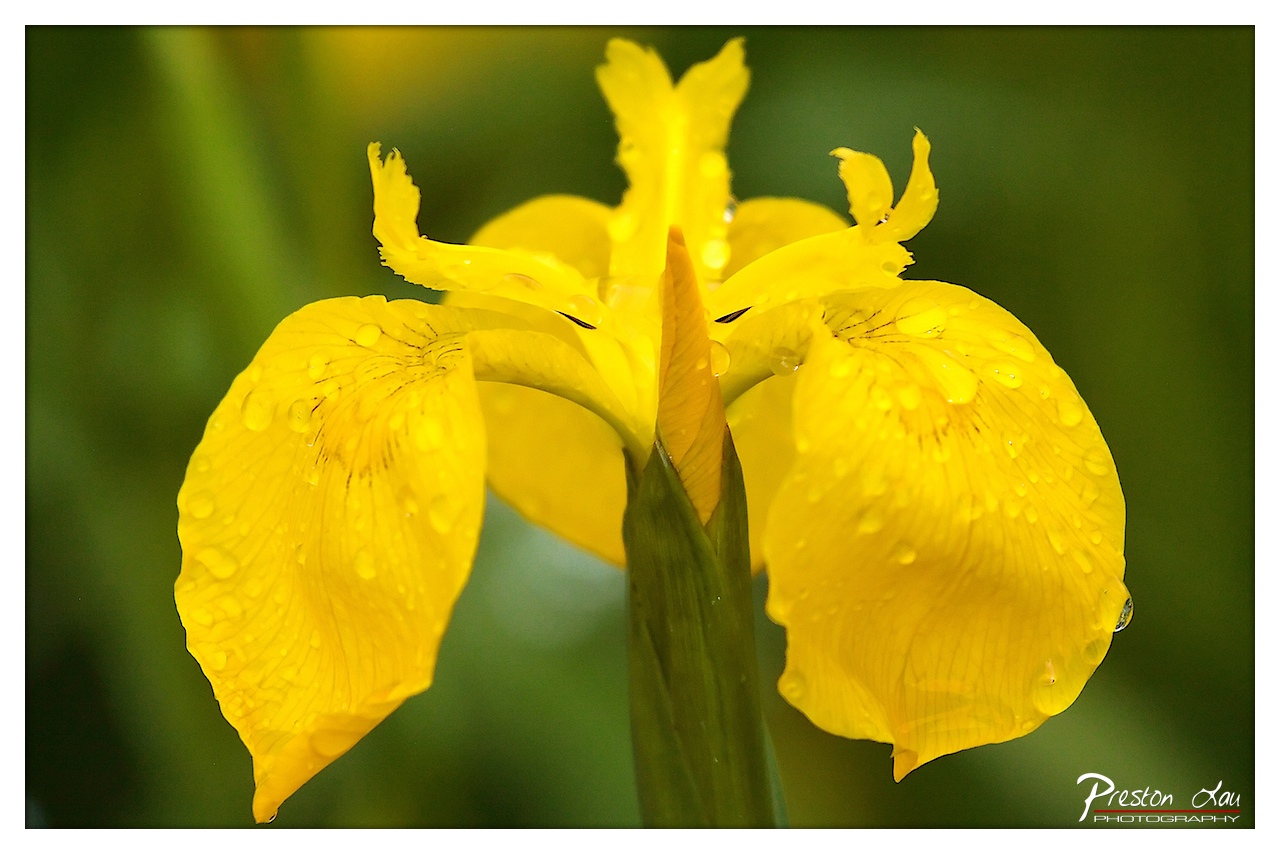

1. Overall Rating (0–10) — 8.0
This photograph captures the delicate beauty of a yellow iris glistening with raindrops, evoking a sense of freshness and renewal. The vibrant yellow petals contrast sharply with the soft, dark green background, creating a striking visual harmony. While the composition is strong and the subject is clearly defined, the image could benefit from slightly more dynamic lighting to enhance depth and texture.
2. Composition (0–10) — 8.0
The flower is centered with a slight off-center tilt, drawing the eye naturally through the bloom’s structure. The use of a shallow depth of field isolates the subject effectively, creating a clean and focused composition.
3. Lighting (0–10) — 7.5
Soft, diffused light highlights the texture of the petals and the clarity of the water droplets, enhancing the natural detail. The lighting is even and flattering, though a touch more directional warmth might add dimension.
4. Color & Tone (0–10) — 8.5
The rich, saturated yellow of the iris stands out vividly against the muted green backdrop, creating a bold and harmonious palette. The tonal contrast is well-balanced, lending the image a fresh, natural feel.
5. Creativity (0–10) — 7.5
The photographer captures a simple yet profound moment in nature with clarity and intention. The focus on water droplets and the close-up perspective offer a fresh, intimate view of the flower, elevating the ordinary into the poetic.
6. Technical Quality (0–10) — 9.0
Sharp focus on the petals and droplets, excellent depth of field control, and clean detail throughout the image reflect strong technical execution. The watermark is discreet and does not distract.
7. Emotional Impact (0–10) — 8.0
The image evokes a sense of calm and renewal, inviting the viewer to pause and appreciate the quiet beauty of a rain-kissed bloom. The clarity and intimacy of the moment foster a quiet emotional connection.
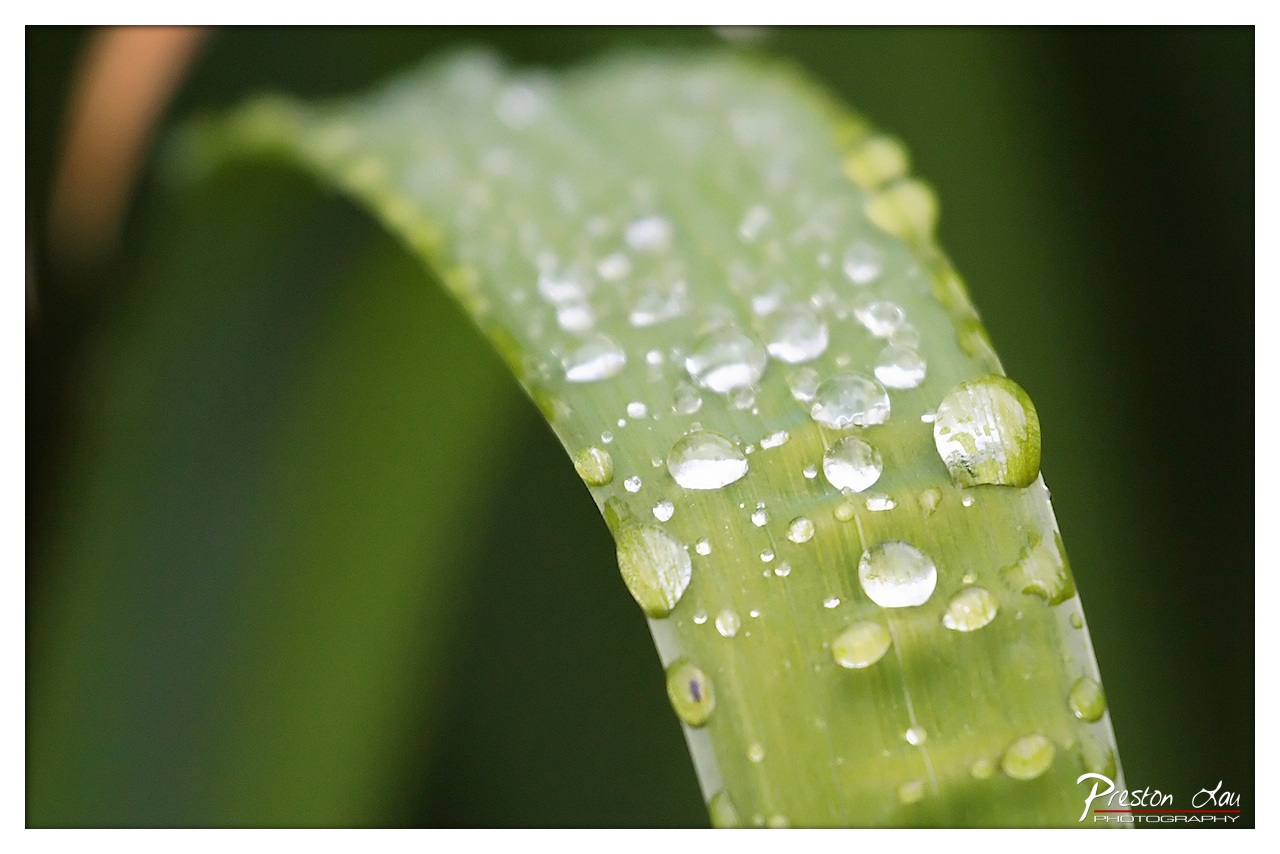

1. Overall Rating (0–10) — 8.0
This image captures a moment of delicate natural beauty, where the interplay of light and water transforms a simple leaf into a glistening canvas. The macro perspective draws the viewer into an intimate world, emphasizing texture and clarity with a serene, almost meditative quality. While the subject is straightforward, the execution elevates it into a study of light and form, though a slightly more dynamic angle might have added narrative depth.
2. Composition (0–10) — 8.0
The diagonal line of the leaf creates a strong visual guide, leading the eye through the frame with natural flow. The shallow depth of field isolates the subject beautifully, while the blurred background enhances focus on the water droplets. The placement of the largest droplet near the lower right adds balance and a subtle point of interest.
3. Lighting (0–10) — 8.5
Soft, diffused light enhances the transparency and refractive quality of the water droplets, creating bright highlights that sparkle without harsh glare. The even illumination reveals fine textures on the leaf surface, while the subtle shadows add depth and dimension.
4. Color & Tone (0–10) — 8.0
The palette is rich with varying shades of green, from deep, muted tones in the background to vibrant, luminous hues on the leaf. The contrast between the translucent droplets and the saturated leaf creates a dynamic visual rhythm. The overall tone is fresh and organic, reinforcing the natural theme.
5. Creativity (0–10) — 7.5
The photograph takes a common natural subject and presents it with a refined, almost poetic sensibility. The focus on macro details and light refraction demonstrates a thoughtful approach, though the composition leans toward the conventional rather than the groundbreaking.
6. Technical Quality (0–10) — 9.0
Exceptional sharpness and clarity define the image, with precise focus on the droplets and leaf surface. The depth of field is expertly managed, and there is minimal noise or distortion. The macro technique is executed with precision, capturing fine textures and light interactions.
7. Emotional Impact (0–10) — 7.5
The image evokes a sense of calm and renewal, inviting quiet contemplation of nature’s small wonders. The glistening droplets and soft focus create a soothing, almost dreamlike atmosphere that resonates with tranquility and freshness.
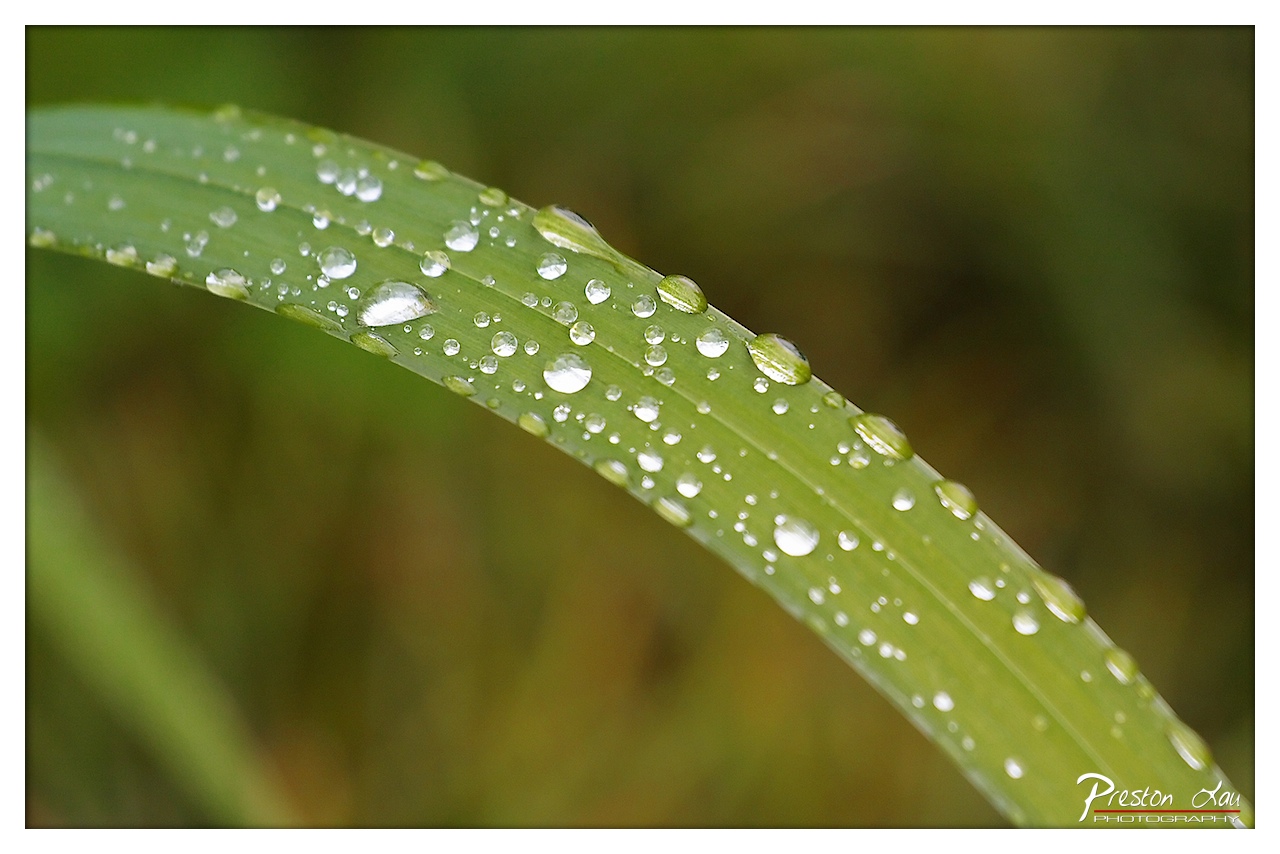

1. Overall Rating (0–10) — 8.0
This image captures a quiet, meditative moment in nature, where the glistening water droplets on a single blade of grass become a microcosm of beauty and renewal. The shallow depth of field isolates the subject with elegance, drawing the viewer into a world of delicate detail. While the scene is simple, it carries a subtle emotional weight—suggesting freshness, stillness, and the quiet aftermath of rain. The composition and lighting work in harmony to elevate a fleeting natural occurrence into something contemplative and visually arresting.
2. Composition (0–10) — 8.0
The diagonal placement of the grass blade creates a strong visual line that guides the eye across the frame, while the soft, out-of-focus background ensures the subject remains the focal point. The balance between the droplets and the negative space enhances the image’s calm, organic rhythm.
3. Lighting (0–10) — 8.5
Soft, diffused light enhances the translucency of the water droplets, allowing them to reflect light like tiny lenses. The gentle illumination highlights the textures of the leaf and creates a luminous quality that adds depth without harsh shadows.
4. Color & Tone (0–10) — 8.0
The palette is composed of rich, natural greens and transparent whites, with a warm, earthy backdrop that adds depth. The tonal contrast between the bright droplets and the darker leaf enhances visual interest, while the overall harmony evokes a sense of calm.
5. Creativity (0–10) — 7.5
The photograph transforms a common natural detail into a moment of quiet beauty through careful framing and focus. While the subject is familiar, the approach is thoughtful and expressive, capturing the poetry of a simple, everyday scene.
6. Technical Quality (0–10) — 9.0
Sharp focus on the central portion of the blade, excellent depth of field control, and clean, noise-free rendering demonstrate strong technical execution. The macro detail is rendered with precision, enhancing the image’s tactile quality.
7. Emotional Impact (0–10) — 8.5
The image evokes a deep sense of peace and renewal, inviting the viewer to pause and appreciate the small wonders of the natural world. Its quiet beauty and meticulous detail resonate emotionally, creating a moment of stillness and reflection.
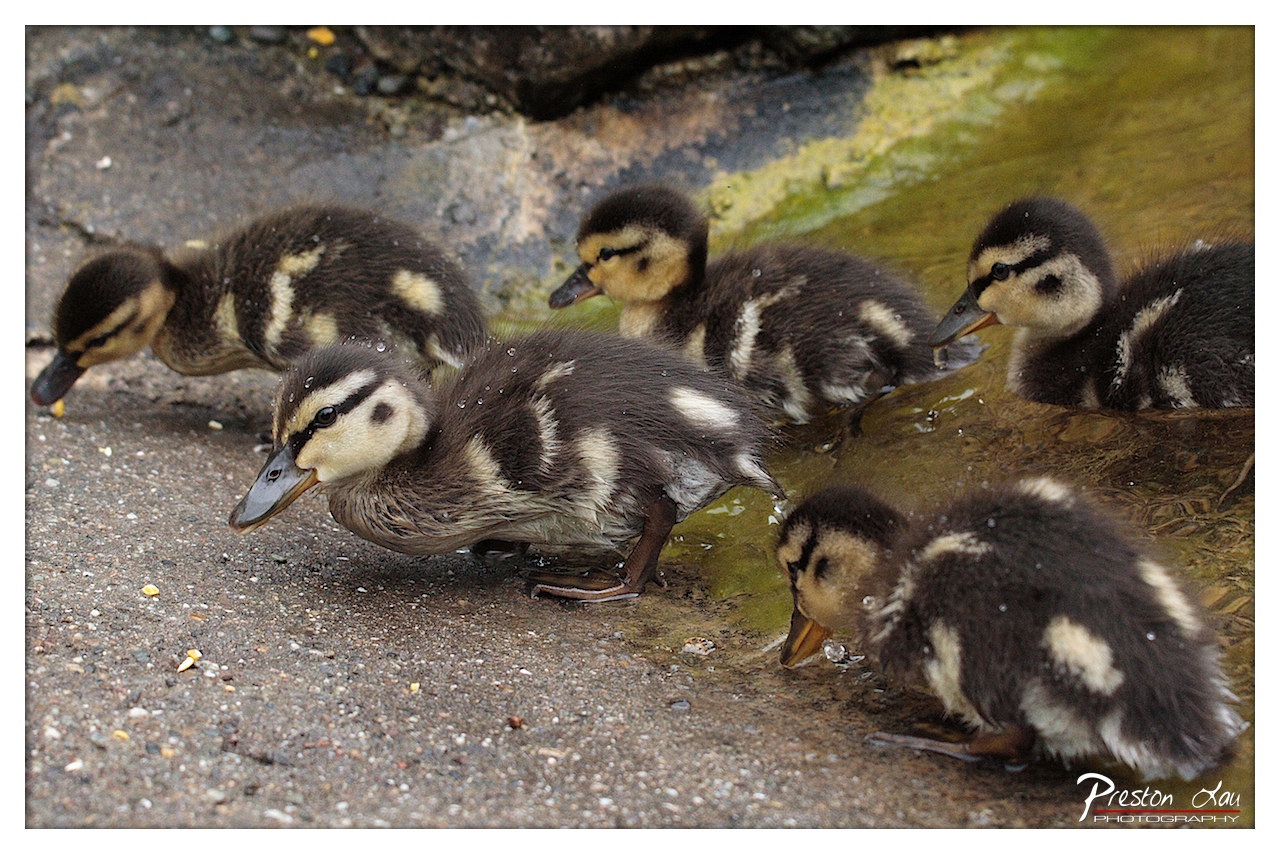

1. Overall Rating (0–10) — 7.5
This photograph captures a tender, lively moment among a brood of ducklings at the water’s edge, where natural curiosity and instinct take center stage. The rich textures of wet feathers, pebbled ground, and rippling water create a tactile, immersive feel, while the ducks’ animated postures convey a sense of gentle urgency. While the image is technically strong and emotionally engaging, the composition’s slight clutter and muted lighting prevent it from achieving a more refined aesthetic.
2. Composition (0–10) — 6.5
The ducklings are arranged diagonally across the frame, creating a dynamic flow, but the foreground clutter and uneven spacing slightly disrupt visual harmony. A tighter crop would enhance focus on the main subjects.
3. Lighting (0–10) — 6.0
Soft, diffused lighting evenly illuminates the scene, preserving detail in the ducklings’ feathers and wet surfaces. However, the lack of directional light or highlights diminishes depth and drama.
4. Color & Tone (0–10) — 7.0
The palette of earthy browns, creamy yellows, and muted greens feels natural and cohesive, with the subtle contrast between wet and dry surfaces adding visual interest. A touch more saturation could enhance the vibrancy of the ducklings’ markings.
5. Creativity (0–10) — 7.5
The image captures a fleeting, authentic moment in nature with a strong sense of narrative—curiosity, movement, and exploration. The photographer’s ability to freeze this interaction demonstrates both patience and sensitivity to behavior.
6. Technical Quality (0–10) — 8.0
Sharp focus on the central duckling, clean detail in the feathers and water droplets, and well-managed depth of field contribute to a technically polished result.
7. Emotional Impact (0–10) — 8.0
The innocence and vulnerability of the ducklings evoke a strong sense of warmth and tenderness. The viewer is drawn into a quiet, intimate moment of life in motion, creating a lasting emotional resonance.
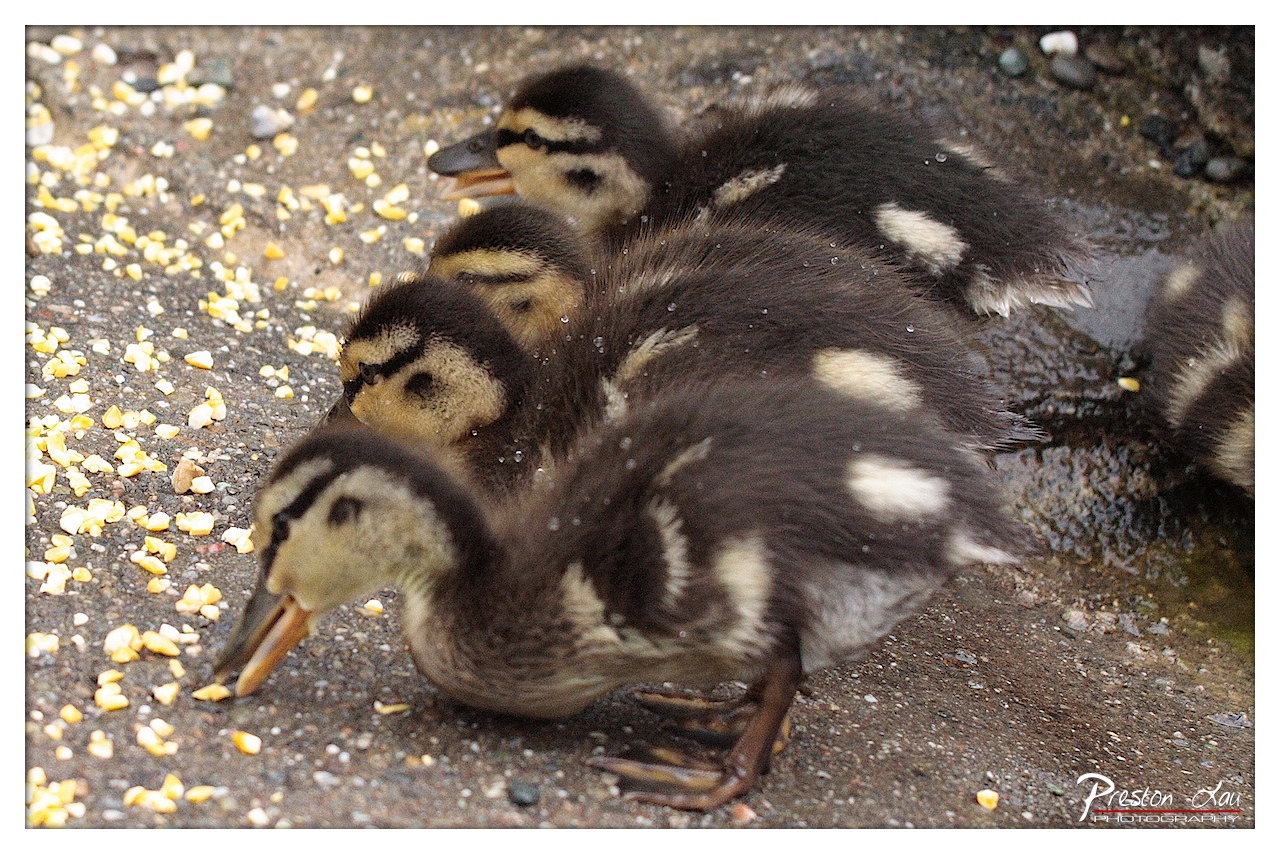

1. Overall Rating (0–10) — 7.0
This photograph captures a tender moment of ducklings feeding, evoking a sense of natural innocence and familial connection. The close-up framing draws the viewer into the small, chaotic world of the chicks, where scattered corn and damp ground add texture and authenticity. While the image feels candid and unposed, it lacks the visual polish to transcend a simple snapshot—its emotional resonance is strong, but its technical execution keeps it grounded in the realm of documentation.
2. Composition (0–10) — 6.5
The diagonal arrangement of the ducklings creates a dynamic flow, leading the eye from the foreground to the background. However, the tight crop and overlapping bodies slightly obscure the full narrative, and the left side feels unbalanced with the concentration of corn.
3. Lighting (0–10) — 6.0
The lighting is soft and diffused, likely from an overcast sky, which minimizes harsh shadows and evenly illuminates the scene. While this suits the natural subject matter, the lack of directional light reduces depth and dimensionality.
4. Color & Tone (0–10) — 6.5
The warm yellows of the corn contrast gently with the dark brown and black of the ducklings, creating a natural palette. The muted tones of the wet pavement and the slight desaturation in the background give the image a subdued, earthy feel, enhancing its authenticity.
5. Creativity (0–10) — 7.0
The photograph captures a charming, unscripted moment in nature, and the tight focus on the ducklings' interaction with their environment adds a layer of narrative. While not groundbreaking, it succeeds in conveying a quiet story of life and survival.
6. Technical Quality (0–10) — 7.5
The image is sharp in the foreground, with clear detail in the ducklings’ feathers and the texture of the corn. The shallow depth of field effectively isolates the subjects, though the background remains slightly distracting due to the scattered debris.
7. Emotional Impact (0–10) — 7.5
The scene elicits warmth and tenderness, especially through the focus on the ducklings’ small, earnest movements. There's a quiet charm in their vulnerability and instinctual behavior, creating a strong emotional pull for viewers who appreciate nature and childhood innocence.


1. Overall Rating (0–10) — 8.0
This photograph captures a tender, intimate moment between two ducklings, their downy feathers glistening with droplets of water as they peck at scattered corn. The composition draws the viewer into the quiet world of young birds, where natural behavior becomes a narrative of survival and curiosity. While the image is rich in texture and emotion, a slightly more deliberate framing could elevate its visual impact.
2. Composition (0–10) — 7.5
The ducklings are well-placed in the foreground, creating a strong focal point, though the background elements—particularly the out-of-focus adult duck—slightly distract from the main subjects. The diagonal line of the feeding duckling guides the eye effectively, but tighter cropping would enhance focus.
3. Lighting (0–10) — 7.0
Soft, diffused light enhances the texture of the ducklings' feathers and highlights the water droplets without harsh shadows. The lighting feels natural and supports the quiet mood, though a touch more directional light might add dimension.
4. Color & Tone (0–10) — 7.5
The warm yellow of the corn contrasts beautifully with the earthy browns and blacks of the ducklings, while the muted green background provides a gentle backdrop. The color palette is natural and harmonious, with just enough saturation to feel alive without appearing over-processed.
5. Creativity (0–10) — 8.0
The photographer captures a fleeting, authentic moment with a strong sense of storytelling. The inclusion of water droplets and the ducklings’ interaction with their environment adds layers of detail that elevate the image beyond a simple wildlife snapshot.
6. Technical Quality (0–10) — 8.5
The image is sharp and well-focused on the ducklings, with a shallow depth of field that effectively blurs the background. The clarity of fine details—feathers, corn kernels, and water beads—demonstrates strong technical execution.
7. Emotional Impact (0–10) — 8.5
There is an immediate sense of warmth and innocence in the scene, evoking feelings of tenderness and connection to nature. The ducklings’ natural behavior and vulnerability create a powerful emotional resonance that lingers with the viewer.


1. Overall Rating (0–10) — 7.5
This photograph captures a tender moment of maternal care in nature, with a mother duck leading her ducklings across a calm, golden-hued pond. The warm tones and gentle ripples enhance the sense of tranquility, while the natural arrangement of the subjects creates a narrative of unity and guidance. Though the image is well-composed and emotionally resonant, the slightly cluttered water surface and lack of dramatic contrast limit its visual impact.
2. Composition (0–10) — 7.0
The mother duck is positioned slightly off-center, drawing the eye across the frame as the ducklings follow in a loose arc. The natural grouping creates a sense of movement and direction, though the background lacks distinct separation, slightly reducing the clarity of the focal point.
3. Lighting (0–10) — 7.5
Soft, diffused lighting enhances the warm golden tones of the water, creating a serene and inviting atmosphere. The even illumination highlights the texture of the duck’s feathers without harsh shadows, contributing to the image’s gentle mood.
4. Color & Tone (0–10) — 8.0
The warm, earthy palette of golden and brown hues creates a cohesive and harmonious visual experience. The contrast between the dark feathers of the ducks and the lighter water enhances their visibility, while the subtle tonal gradations add depth.
5. Creativity (0–10) — 7.0
The image captures a classic wildlife moment with a strong sense of narrative, emphasizing the bond between mother and offspring. While not overtly experimental, the thoughtful composition and natural setting lend it a quiet artistic strength.
6. Technical Quality (0–10) — 8.0
Sharp focus on the ducks, particularly the mother, ensures clarity of detail. The image is well-exposed with minimal noise, and the water’s texture adds visual interest without distracting from the main subjects.
7. Emotional Impact (0–10) — 8.5
The photograph evokes a deep sense of warmth, protection, and familial connection. The viewer is drawn into the quiet journey of the duck family, creating a heartfelt and universally relatable moment.
Loading map...